50 I Believe Essay Topics
To better train students on how to present their personal opinions on subjective matters, teachers will assign what is known as an “I Believe” or “This I Believe” essay writing assignment.
Designed to provide the reader with insight into the writer’s character, these essays are typically written in first-person point of view. The writer shares their beliefs on a particular topic – ranging from religion and politics to more personal subjects such as love and happiness – and offers supporting arguments for why they hold these beliefs.

The Challenges of Writing “I Believe” Essays
This type of essay prompt is a welcome break from more detail-oriented or researched-based writing assignments for many students. However, “I believe” essay writing assignments aren’t always easy.
It can be challenging for students to articulate their beliefs in a clear and concise way that isn’t argumentative or offensive to the reader. Students may also struggle to explain their reasoning behind these beliefs in a thorough and not overly simplistic way.
Despite these challenges, “I believe” essays can be an excellent opportunity for students to share their thoughts and feelings on important topics and learn more about themselves in the process.
Tips for Writing “I Believe” Essays
If you’re given an “I believe” essay assignment, here are a few tips to help you get started:
- Start by defining what it is that you believe. This may seem like a simple task, but it can be challenging to identify your core beliefs. If you’re struggling, start by jotting down a list of topics that are important to you – from politics and religion to family and friendship.
- Reflect on why each topic is important to you. Think about the reasoning behind your choices and how these reasons evolved over time. After all, your core beliefs are likely to have changed or grown since you reached adolescence.
- Determine which of your beliefs are the most important. Focusing on developing thought processes that support your beliefs. For extra help, consider sharing these thoughts with a trusted friend or family member for advice.
By reflecting upon your core beliefs and developing clear arguments to support them, you can craft a powerful “I believe” essay that will truly reflect your thoughts and feelings.
How to Write an “I Believe” Essay
To craft a well-written “I Believe” essay, students must forgo the typical essay structure of introduction, body, and conclusion.
Instead, the essay should be organized around a series of specific beliefs that the writer wishes to share. Each thought should be introduced with a clear thesis statement, followed by supporting arguments and examples.
The conclusion of the essay should wrap up the main points that have been made and leave the reader with a final thought to ponder.
Here is an example of how an “I Believe” essay might be structured:
Thesis: I believe that everyone has the right to love and be loved.
Argument: Everyone deserves to find love and experience happiness in their lives. This should not be limited by race, religion, socioeconomic status, or any other factor.
Example: I saw a video of a man proposing to his girlfriend at Fenway Park. She said yes and the crowd went wild! Now that is love. If they can find it, then so can we all!
Conclusion: Society should not stand in the way of love. Love is the most powerful force in the world, and we should all embrace it.
As you can see, the “I Believe” essay structure allows for a great deal of flexibility. Students can choose to focus on a variety of topics and can organize their essays in different ways. An “I Believe” essay can be an excellent opportunity for students to present their thoughts on important issues under a few simple guidelines. With a bit of planning and organization, this type of essay writing assignment can be a breeze!
What You Shouldn’t Do When Writing an “I Believe” Essay
To ensure that you are writing an “I Believe” essay and not another form of an argumentative or persuasive essay, avoid doing the following:
- Don’t provide evidence or use statistics to support your position – this is not an essay that calls for research.
- Don’t attack or criticize the beliefs of others – your goal is to share your own opinions, not to tear down those of others.
- Don’t go off on tangents – stay focused on the main points you want to make.
- Don’t speak objectively or in the third person – for example, don’t say “people believe that” or “studies show.”
- Don’t use filler words and phrases such as “I think,” “I feel,” and “it seems like.”
Use any of these 50 “I Believe” essay topics to help you brainstorm ideas for your essay!
I Believe Essay Topics About Life
- I believe that life is too short to spend time with people who bring you down.
- I believe that laughter is the best medicine
- I believe that we should make time for quiet reflection every day.
- I believe that the only thing that matters in life is love.
- I believe that we are all capable of change.
- I believe that it is never too late to learn and grow.
- I believe in the power of positive thinking.
- I believe that we should always be kind, even when it is difficult.
- I believe that there is no such thing as a coincidence.
- I believe in the saying “what goes around, comes around.”
- I believe that we are all responsible for our own happiness.
- I believe that the best things in life are free.
- I believe that it is essential to be grateful for what we have.
- I believe that it is never too late to achieve our dreams.
- I believe that we should surround ourselves with people who make us better.
- I believe that you can either love or hate something; there is no in-between.
I Believe Essay Topics About Education & School
- I believe that education is the key to a bright future
- I believe that children are our future and should be treasured as such.
- I believe that there is no such thing as a dumb question.
- I believe that schools should do more to celebrate diversity.
- I believe that homework is essential, but it should not be excessive.
- I believe in the importance of having a strong support system while attending school.
- I believe that standardized tests are not an accurate measure of a student’s knowledge.
- I believe that it is vital to find a balance between work and play while in school.
- I believe that everyone should have the opportunity to learn how to swim.
- I believe in the importance of recess and physical activity in students’ lives.
- I believe that there is no such thing as a bad grade.
- I believe that teachers deserve more respect and better pay.
- I believe that it is never too early to learn a foreign language.
- I believe that education should be free for everyone.
I Believe Essay Topics About Friends & Family
- I believe that family is the most important thing in life.
- I believe that friends are the family we choose for ourselves.
- I believe that it is essential to maintain close relationships with friends and family.
- I believe that there is no substitute for quality time spent with loved ones.
- I believe that family is not defined by blood but by love and commitment.
- I believe that we should spend more time with the people we care about and less time worrying about material things.
- I believe that it is better to have a few close friends than many superficial ones.
- I believe that it is healthy for friends to grow apart.
- I believe that competition between friends is healthy.
I Believe Essay Topics About Money
- I believe that money cannot buy happiness.
- I believe that it is essential to be happy with what you have, not what you want.
- I believe that people are more important than things.
- I believe that it is okay to splurge on something even if it means going into debt.
- I believe that it is better to give than to receive.
- I believe that money can’t buy everything.
- I believe that the love of money is the root of all evil.
- I believe in saving for a rainy day.
- I believe in investing in oneself.
- I believe in the saying, “money doesn’t grow on trees.”
- I believe that rich people should be forced to pay more taxes.
These 50 I Believe essay topics are sure to inspire your own original beliefs and help you create a powerful and unique essay. When writing your I Believe essay, be sure to focus on the beliefs that are most important to you and that you feel passionate about discussing. The best I Believe essays are the ones that are personal and reflective, so don’t be afraid to share your own thoughts and experiences.
Related Posts
- 130 Immigration Essay topics
- 220 Psychology Essay Topics
- 125 Analytical Essay Topics
- 120 Argumentative Essay Topics
- 120 Literary Essay Topics
Categories:
- Essay Samples
- Essay Topics
- Essay Writing Guides
Recent posts:
- 170 Ethics Essay Topics
- 160 Satire Essay Topics
- 160 Rhetorical Essay Topics
- 155 Criminal Justice Essay Topics
- 150 Political Essay Topics
- 145 Classification Essay Topics
- 140 Sociology Essay Topics
- 140 Opinion Essay Topics
- 140 Environmental Essay Topics
- 135 Controversial Essay Topics
- 125 Classification and Division Essay Topics
- 100 Profile Essay Topics
- 90 Heart of Darkness Essay Topics
- 80 Holocaust Essay Topics
Testimonials


Want to create or adapt books like this? Learn more about how Pressbooks supports open publishing practices.
32 “This I Believe” Essay
The history of ‘this i believe’.
by Tanya Matthews
This I Believe is an exciting media project that invites individuals from all walks of life to write about and discuss the core beliefs that guide their daily lives. They share these statements in weekly broadcasts on NPR’s Morning Edition and All Things Considered .
The series is based on the 1950’s radio program This I Believe , hosted by acclaimed journalist Edward R. Murrow. Each day, some 39-million Americans gathered by their radios to hear compelling essays from the likes of Eleanor Roosevelt, Jackie Robinson, Helen Keller and Harry Truman as well as corporate leaders, cab drivers, scientists and secretaries — anyone able to distill into a few minutes the guiding principles by which they lived. Their words brought comfort and inspiration to a country worried about the Cold War, McCarthyism and racial division.
Eventually, the radio series became a cultural phenomenon. Eighty-five leading newspapers printed a weekly column based on This I Believe . A collection of essays published in 1952 sold 300,000 copies — second only to the Bible that year. The series was translated and broadcast around the globe on the Voice of America. A book of essays translated into Arabic sold 30,000 copies in just three days.
[The NPR series This I Believe can be read and heard here . In addition, the website and organization This I Believe houses thousands of essays written by famous people, such as the ones mentioned above, and everyday people like you and me.]
As a college student in 2020, you are faced with turbulent politics, socioeconomic issues, and ethical dilemmas that will challenge you to take a stand and contribute to the local, national, and global conversation around you. The purpose of this writing task is not to persuade you to agree on the same beliefs. Rather, it is to encourage you to begin the much more difficult task of developing respect for beliefs different from your own. Fifty years ago, Edward R. Murrow’s project struck such a chord with millions of Americans. It can do so again today…with you.
Video Resources for Generating Ideas
Dan gediman on writing a “this i believe essay”.
Read Cecelia Munoz’s essay “Getting Angry Can Be a Good Thing” referred to in the previous video here .
“This I Believe” Essay with Animation
“This I Believe” Essay Ideas
Prewriting Activity
1) analyze others’ statements.
Consider the following statements, written in response to the question What Have You Learned About Life? Highlight any sentences that resonate with you. Talk about them with a partner or group, explaining why. 1. I’ve learned that when I wave to people in the country, they stop what they are doing and wave back. – Age 9 2. I’ve learned that if you want to cheer yourself up, you should try cheering someone else up. – Age 14 3. I’ve learned that although it’s hard to admit it, I’m secretly glad my parents are strict with me. – Age 15 4. I’ve learned that if someone says something unkind about me, I must live so that no one will believe it. – Age 39 5. I’ve learned that there are people who love you dearly but just don’t know how to show it. – Age 42 6. I’ve learned that you can make someone’s day by simply sending them a little note. – Age 44 7. I’ve learned that the greater a person’s sense of guilt, the greater his or her need to cast blame on others. – Age 46 8. I’ve learned that no matter what happens, or how bad it seems today, life does go on, and it will be better tomorrow. – Age 48 9. I’ve learned that regardless of your relationship with your parents, you miss them terribly after they die. – Age 53 10. I’ve learned that making a living is not the same thing as making a life. – Age 58 11. I’ve learned that life sometimes gives you a second chance. – Age 62 12. I’ve learned that whenever I decide something with kindness, I usually make the right decision. – Age 66 13. I’ve learned that it pays to believe in miracles. And to tell the truth, I’ve seen several. – Age 75 14. I’ve learned that even when I have pains, I don’t have to be one. – Age 82 15. I’ve learned that every day you should reach out and touch someone. People love that human touch—holding hands, a warm hug, or just a friendly pat on the back. – Age 85 16. I’ve learned that I still have a lot to learn. – Age 92
2) Compose Your Own Statement
Write down a sentence that expresses what YOU have learned about life. Maybe it is similar to one of the statements above; maybe it’s completely different. Whatever it is, write it down.
3) Freewrit e
Now free-write about your sentence. Include at least two examples / experiences that you have had that support why you think this way.
Personal Statement/Philosophy: ______________________________________________________________________________________________________________________________________________________ Why do you believe in this statement? ______________________________________________________________________________________________________________________________________________________ Name two experiences that you had that would support the statement: _______________________________________________________________________________________________________________________________________________________________________________________________________________________________________________________________________________________________________________________________________________________________________________________ What does this say about yourself or your personality? _________________________________________________________________________________________________________________________________________________________________________________________________________________________________ After your life experience, how have you come to the conclusion that this should be your statement? How have your beliefs changed, if at all? ____________________________________________________________________________________________________________________________________________________________________________________________________________________________________________________________________________________________________________ How has the event effected your relationship with a person, place, or object? _________________________________________________________________________________________________________________________________________________________________________________________________________________________________ How does your statement apply to you today? (How you view yourself & society) ______________________________________________________________________________________________________________________________________________________
SAMPLE STUDENT ESSAYS
Sample #1: america’s beauty is in its diversity.
written by Alaa El-Saad, high school student, as heard on NPR’s Tell Me More (2009)
America is built on the idea of freedom, and there is no exception for Muslim women. I believe in the freedom of religion and speech. But mostly, I believe it’s OK to be different, and to stand up for who and what you are. So I believe in wearing the hijab.
The hijab is a religious head covering, like a scarf. I am Muslim and keeping my head covered is a sign of maturity and respect toward my religion and to Allah’s will. To be honest, I also like to wear it to be different. I don’t usually like to do what everyone else is doing. I want to be an individual, not just part of the crowd. But when I first wore it, I was also afraid of the reaction that I’d get at school.
I decided on my own that sixth grade was the time I should start wearing the hijab. I was scared about what the kids would say or even do to me. I thought they might make fun of me, or even be scared of me and pull off my headscarf. Kids at that age usually like to be all the same, and there’s little or no acceptance for being different.
On the first day of school, I put all those negative thoughts behind my back and walked in with my head held high. I was holding my breath a little, but inside I was also proud to be a Muslim, proud to be wearing the hijab, proud to be different.
I was wrong about everything I thought the kids would say or even do to me. I actually met a lot of people because of wearing my head covering. Most of the kids would come and ask me questions—respectfully—about the hijab, and why I wore it.
I did hear some kid was making fun of me, but there was one girl—she wasn’t even in my class, we never really talked much—and she stood up for me, and I wasn’t even there! I made a lot of new friends that year, friends that I still have until this very day, five years later.
Yes, I’m different, but everyone is different here, in one way or another. This is the beauty of America. I believe in what America is built on: all different religions, races and beliefs. Different everything.
Sample #2: The Essentials to Happiness
written by Alexxandra Schuman, high school student, as heard on The Bob Edwards Show (2013)
As a child, I was generally happy; singing and dancing to my favorite songs; smiling and laughing with my friends and family. But as far back as second grade, I noticed a “darkness,” about me. I didn’t enjoy engaging in many things. I didn’t relate to my peers in elementary school because they appeared so happy, and I didn’t have that ability to achieve happiness so easily.
In middle school things in my life began to get even worse. I began withdrawing from everything I once enjoyed; swimming, tennis, family. I hated going to sleep knowing I had to wake up to another day. I was always tired. Everything was horrible. Finally, midway through eighth grade, I was told I had a chemical imbalance; diagnosed with clinical depression and put on medication. It took months for me to feel the effects of the medication.
When I began to feel happy again, is when I realized that I had to take the responsibility for getting better myself, rather than relying on medication and therapy alone. Aristotle said, “To live happily is an inward power of the soul,” and I believe that this quote describes what I had to do to achieve happiness. Happiness is a journey. Everyone seems to need different things to be happy. But I believe people are blinded from what truly makes one happy.
Growing up, we’re encouraged to be successful in life; but how is success defined? Success and happiness are imagined now as having a lot of money. It is so untrue. Recently I went to Costa Rica and visited the small town of El Roble. I spent the day with a nine-year old girl named Marilyn. She took me to her house to meet her parents. It was obvious that they were not rich; living in a small house with seven children. The house was cluttered but full of life. Those who have decided that success and happiness comes from having money and a big house would be appalled at how utterly happy this family from El Roble is. People say that seeing things like that make you appreciate what you have, but for me, it made me envy them for being so happy without all the things I have.
“The essentials to happiness are something to love, something to do, and something to hope for,” a quote from William Blake sums up what I believe people need to realize to be truly happy in life. People need love; I feel they need their family and their friends more than anything in the world. People need work to do, something to make them feel they are making a difference in the world. People need to know that more good is to come in the future, so they continue to live for “now” instead of constantly worrying about the bad that could come. And most importantly people need to know that happiness is not something that happens overnight. Love and hope is happiness.
Sample #3: Find a Good Frog
written by Delia Motavalli, high school student, as heard on The Bob Edwards Show (2013)
I believe in finding a good frog. It seems that all throughout childhood, we are taught to look for a happily ever after. “And they all lived happily ever after”; isn’t that the conclusion to many children’s films? When I was a kid I always thought of that as magical; but now really it just seems unrealistic. And it teaches us that what we want is a fairytale like they have in the storybooks. We all want to be Cinderella who gets swept off her feet by the hot prince; we want to live in the royal castle, right? But I don’t think that’s necessarily a good thing for us to seek. Now I’m not saying I believe in being pessimistic, but I do believe in being realistic; it’s something I got from my mom.
My mother and I always have our best conversations in the rain. We sit in the car, neither of us wanting to brave the rain to get to the house. So we sit. We watch droplets race down the windshield, listen to the rain strike the roof of her little blue Honda, and feel the heater on full-blast rushing at our feet (just the way we like it). I don’t know why, but sitting in the car, we always talk more than normal. There was one rainy day when my mom told me something that is going to stick with me forever. Earlier that day she and my dad had been arguing about something; I can’t remember what. So she said, “Don’t spend your life looking for Prince Charming. Instead, find yourself a really good frog.”
At the time, I found this thought really disheartening. Who wants to think that you’ll never find Prince Charming? You’ll never get to be Cinderella? Another thought that struck my mind: if my mom says there’s no Prince Charming, then what’s my dad? A frog? I asked her, and she replied with, “Of course! If he were Prince Charming, he wouldn’t snore, would be able to cook, and we would never argue. But you know what? He’s a damn good frog.” Of course, being young, I didn’t think of the meaning behind what she was saying. I was too busy thinking of it literally, visualizing my mom as a princess and my dad in frog form.
But a few years later, I understand the value of my mom’s words. You can’t expect everything to be perfect. Let’s be completely honest; if you wait your whole life for your prince with flowing hair, statuesque features, and a white horse, you’re going to be lonely. I think that the point of finding a good frog is you accept something that’s great, flaws and all. It’s so easy to be picky. You can find the one tiny thing that’s wrong, and that one tiny thing is what you can’t get your mind off of. But in life, we can’t afford to wait years in vain for perfection. So I think that a good frog, an amazing frog, the best frog you can find is what we’re really looking for in this world. Don’t laze through life waiting for a happily ever after, because I don’t think you’ll be very happy with the outcome.
Examples from the ‘This I Believe’ Website
Be Cool to the Pizza Dude by Sarah Adams
They Lived Their Faith by Charles Henry Parrish
Returning to What’s Natural by Amelia Baxter-Stoltzfus
The Birthright of Human Dignity by Will Thomas
Remembering All The Boys by Elvia Bautista
I Am Still The Greatest by Muhammad Ali
A Goal Of Service To Humankind by Anthony Fauci
My Life Is Better by Abraham
Give Me a Waffle by Brenda
The Little Things by Sophie Crossley
You can also browse thousands more This I Believe essays by theme .
Prefer to Listen to Get Inspiration?
Check out This I Believe’s Podcast Series
4) Drafting
Assignment guidelines + suggestions and tips for drafting.
1. While the examples you’ve been given can serve as a model, it is essential that each of you write about a personal belief or philosophy that you feel strongly about. 2. Tell a story. Personal experiences are the corner stone of a good essay. Your story doesn’t have to be a heart breaker or even a major event, but it must be something that has affected how you think, feel, and act. List your personal experiences that you intend to use as evidence below: 3. Be concise. Avoid repetition. This essay should be between 500 – 650 words. When read aloud, it should take roughly four minutes. 4. Name your belief. It is essential that you can name your belief in a sentence or two. Focus on one belief only. This is your thesis. Write it here: 5. Be positive. Avoid preaching or persuading. You aren’t trying to change the way others think or act. Write about what you believe, not what you don’t believe. 6. Use the first person. Speak for yourself. Avoid using we or you. 7. Let your voice shine. Use language that sounds like you. Read it aloud as your revise. Keep making changes until your essay sounds like you and captures the essence of your belief.
5) Peer Review
Once you have written your first draft, arrange for your essay to be edited by a peer, using the following Peer-Editing Checklist: Writer’s Name: ________________________________________________ Peer Editor’s Name: ________________________________________________ Use your PENCIL or PEN (NOT red or green) to make corrections. Remember, this essay is a work in progress. You are not done writing! Look for ways to improve what you’ve already written. Tick each step if it has been completed. _____ 1. Read the paper backwards, one sentence at a time. Check for spelling errors. Use a dictionary, a friend, or a spell checker to find the correct spelling. _____ 2. Check for capitalized proper nouns and the first word of each sentence. _____ 3. Skip a line between each paragraph. _____ 4. Every sentence should have end punctuation. _____ 5. Check commas. Are they only used for compound sentences, a list of items, an introductory word or phrase, direct address, setting off interruptions, separating adjectives, or in dates? Do you need to add commas? Make sure you do not have commas separating complete sentences (i.e. comma splice errors that create run-on sentences). _____ 6. Apostrophes are used only for contractions and to show ownership. _____ 7. The use of more complex punctuation (dashes, hyphens, semi-colons, parentheses, etc.) is done correctly. _____ 8. Have you used commonly mixed pairs of words correctly? Check these: they’re/their/there, your/you’re, it’s/its, a/an, to/too/two, are/our/hour, and others. _____ 9. Read the paper backwards one sentence at a time. Check for sentence fragments and run-ons and correct them. _____ 10. Did you stay in present tense (such as is, am, do, take, know, etc.) or past tense (such as was, were, did, took, knew, etc.) throughout the entire essay? _____ 11. Did you stay in first person (I, me, my, we, us, our) or third person (he, him, she, her, they, them, their) throughout the entire essay? _____ 12. Was there adequate use of specific details and sensory details? Were the details clear and relevant to the statement? _____ 13. Is the overall purpose/philosophy clear? _____ 14. Does the conclusion make you go, “Wow!” “Cool!” “I never thought about it that way,” or any other similar reaction? Other suggestions for the overall content of the piece: ____________________________________________________________________________________________________________________________________________________________________________________________________________________________________________________________________________________________________________
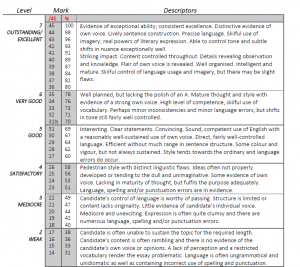
This I Believe by Tanya Matthews is licensed by CC-BY-SA
“This I Believe” Essay Copyright © 2020 by Liza Long; Amy Minervini; and Joel Gladd is licensed under a Creative Commons Attribution-ShareAlike 4.0 International License , except where otherwise noted.
Share This Book

This I Believe Essay

In the realm of personal expression and introspection, the “This I Believe” essay stands as a testament to the power of individual beliefs and narratives. Rooted in the context of personal experiences and convictions, these essays provide a platform for individuals to articulate their core principles, values, and perspectives. Through the use of various literary devices and elements , authors craft narratives that illuminate their unique outlook on life. In this article, we will delve into the definition of a This I Believe essay, present a step-by-step guide on how to craft one, address common questions, and explore the essence of this expressive form.
1. High School This I Believe Essay Example
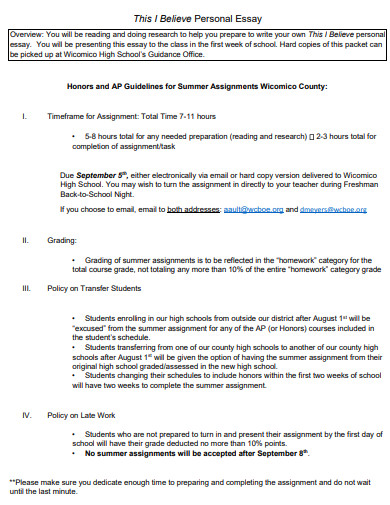
Size: 487 KB
2. Sample This I Believe Essay Example
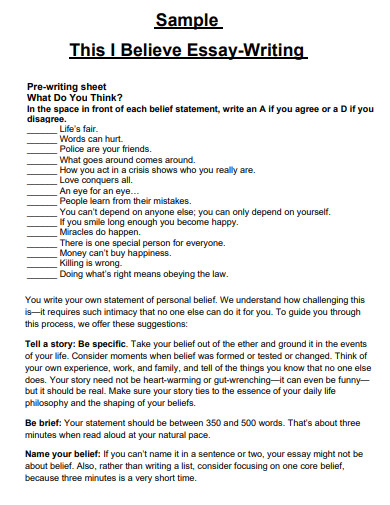
Size: 47 KB
3. Student This I Believe Essay Example
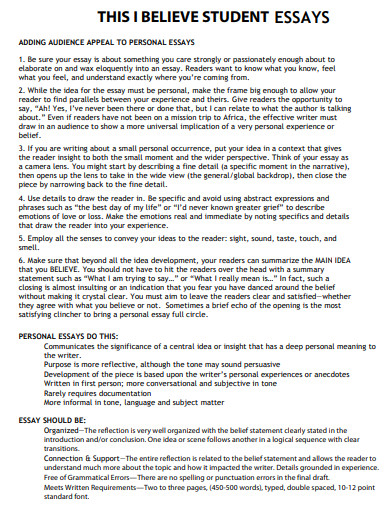
Size: 173 KB
4. Middle School This I Believe Essay Example

Size: 270 KB
5. This I Believe Essay Topic Example
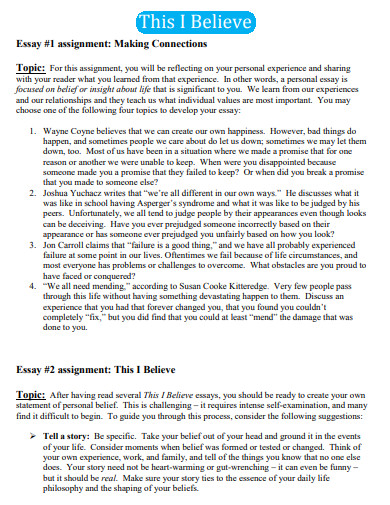
Size: 532 KB
6. This I Believe Essay Life Example

Size: 101 KB
7. This I Believe Essay Overview Example
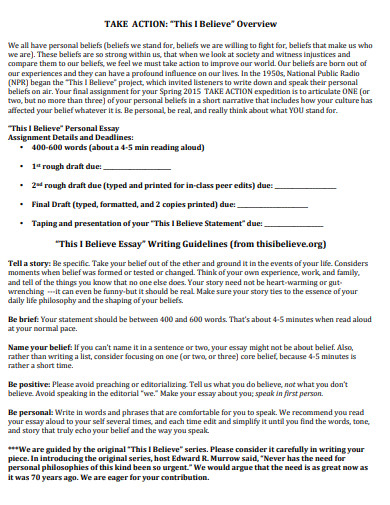
Size: 67 KB
8. This I Believe Essay Steps Example
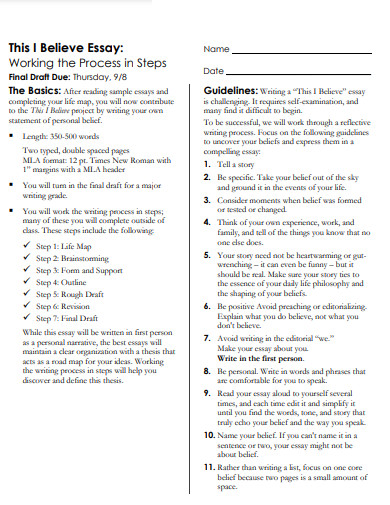
Size: 156 KB
9. This I Believe Essay Friendship Example
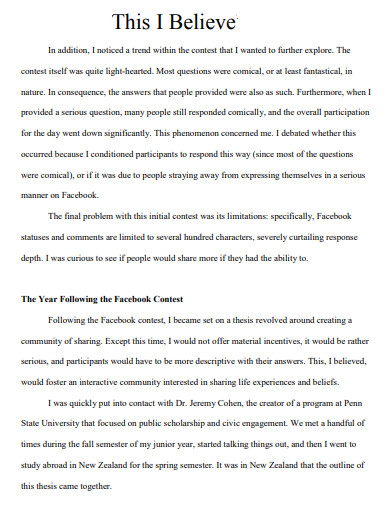
Size: 426 KB
10. Sports This I Believe Essay Example
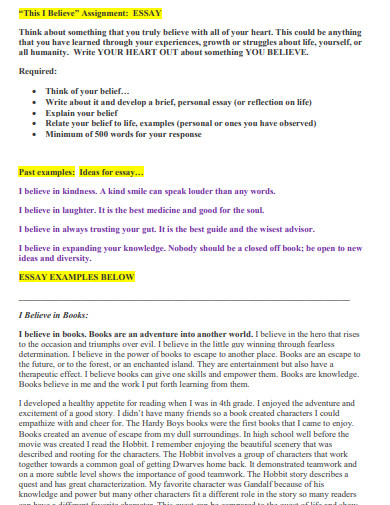
Size: 159 KB
11. This I Believe Essay Rubric Example
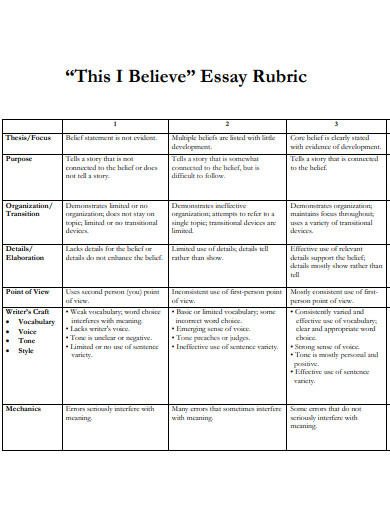
Size: 84 KB
12. This I Believe Personal Essay Example
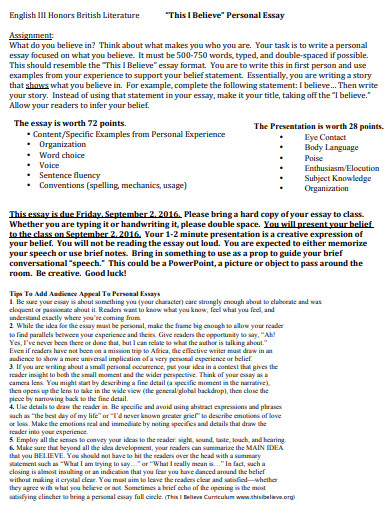
Size: 104 KB
13. This I Believe Essay Writing Example

Size: 175 KB
14. This I Believe Essay Statement Example
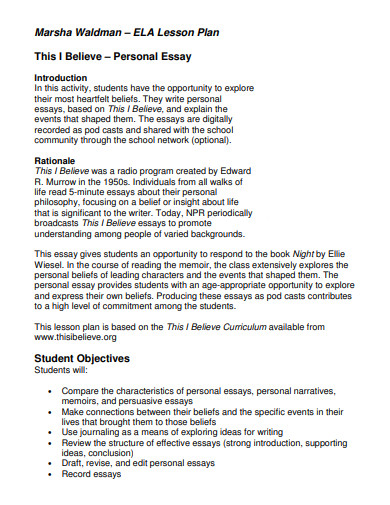
Size: 55 KB
15. God This I Believe Essay Example
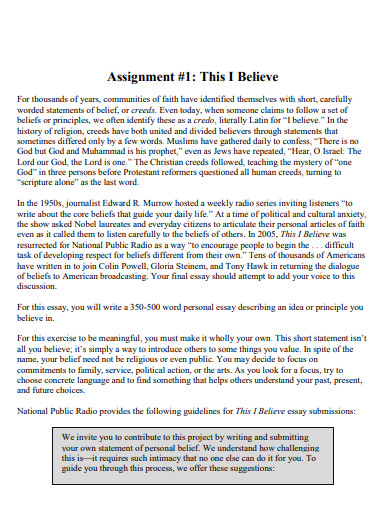
Size: 117 KB
16. This I Believe Essay Brief Example
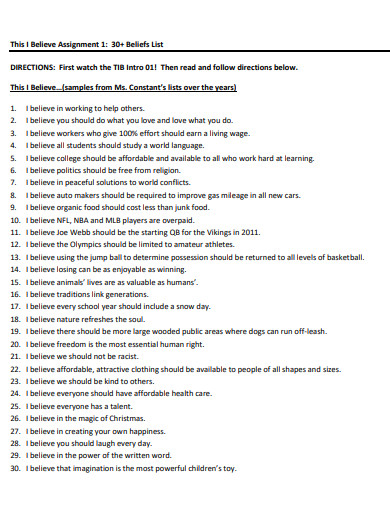
Size: 121 KB
17. This I Believe Essay Thesis Statement Example
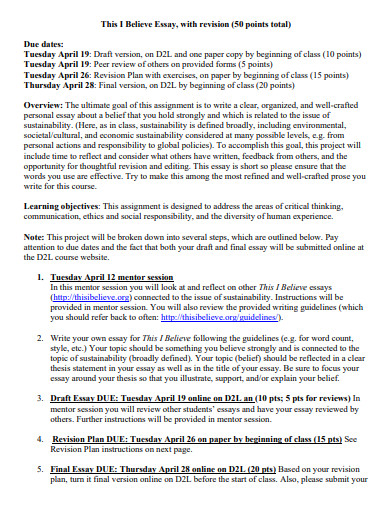
Size: 11 KB
18. This I Believe Essay Speech Example
19. this i believe essay college example.
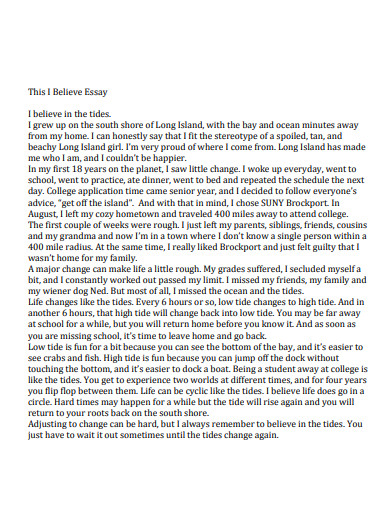
Size: 66 KB
20. This I Believe Essay Lesson Plan Example
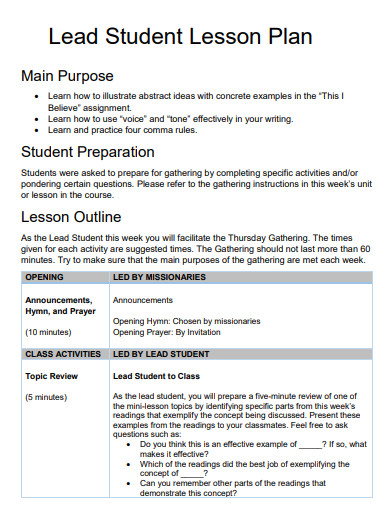
Size: 63 KB
21. This I Believe Essay Music Example
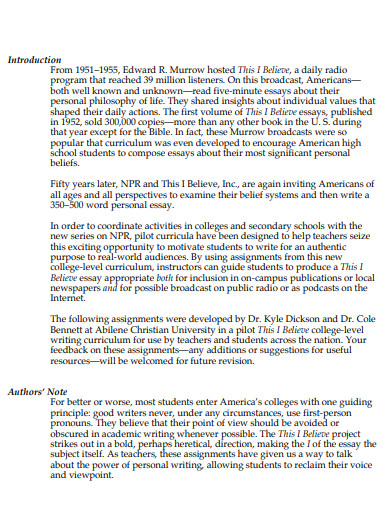
Size: 406 KB
22. Faith This I Believe Essay Example
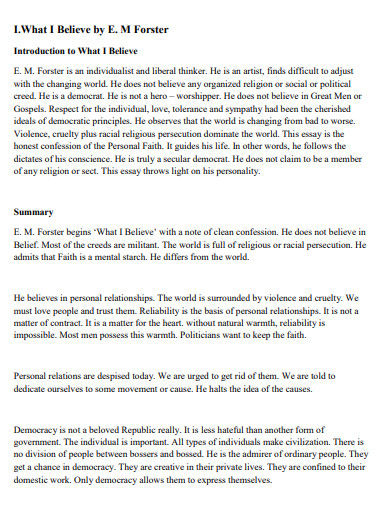
Size: 198 KB
23. Reflection This I Believe Essay Example

Size: 37 KB
24. This I Believe Immigration Essay Example
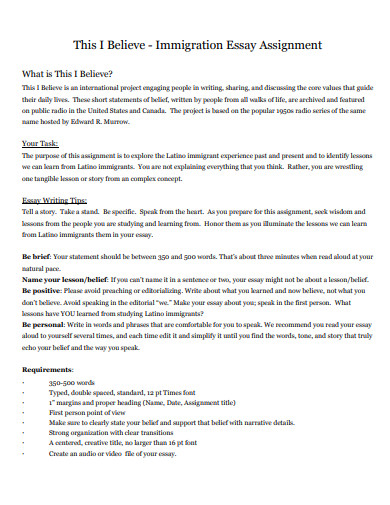
Size: 50 KB
25. This I Believe Love Essay Example
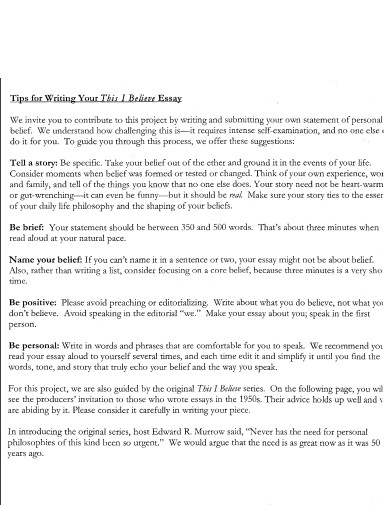
Size: 709 KB
26. This I Believe Dream Essay Example
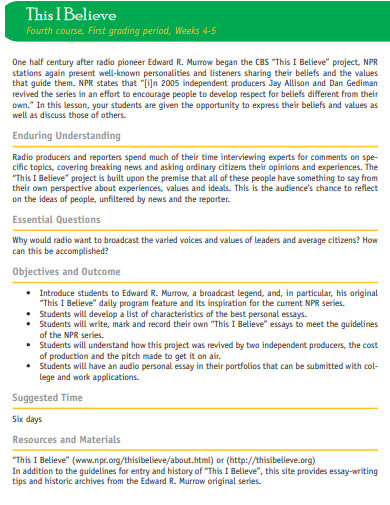
Size: 154 KB
27. This I Believe Power Essay Example
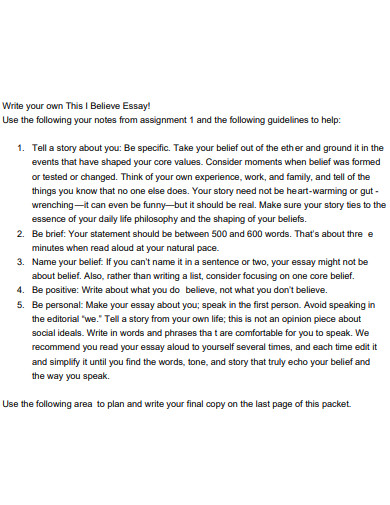
Size: 89 KB
28. This I Believe Essay Prompt Example
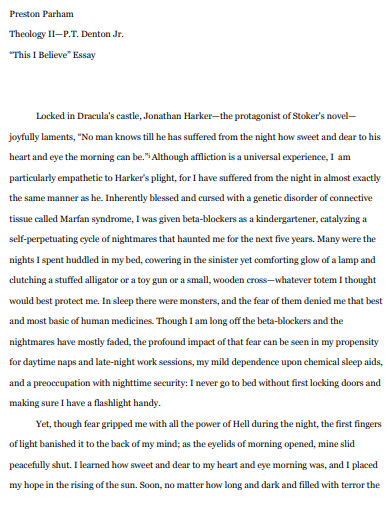
Size: 51 KB
29. This I Believe Essay Peer Review Example
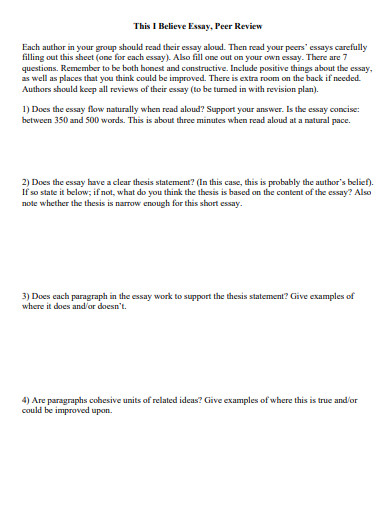
30. Elements of This I Believe Essay Example
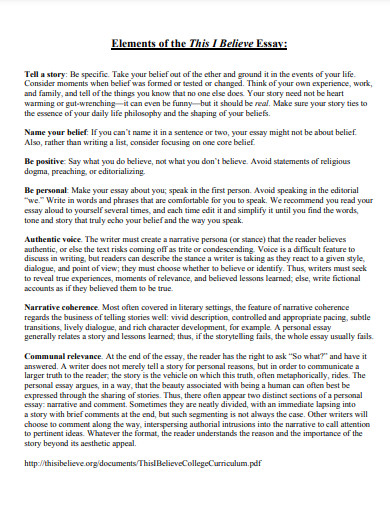
31. This I Believe Essay Transcript Example
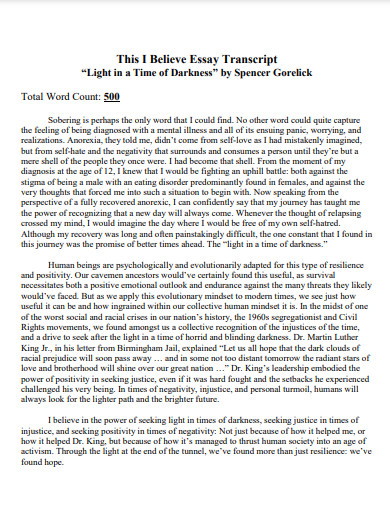
Size: 259 KB
What is a This I Believe Essay?
A This I Believe essay is a written composition that encapsulates an individual’s personal beliefs, values, and philosophies. Often reflective and intimate in nature, these essays offer readers insight into the author’s subjective understanding of the world. They provide an opportunity to explore the depth of one’s convictions, making use of various literary devices and characteristics to convey a sense of authenticity and sincerity. Through the exploration of individual experiences and convictions, these essays aim to connect with readers on a personal and emotional level.
How to Write a This I Believe Essay
Step 1: choose your core belief.
At the heart of your essay lies your core belief. Choose a belief that holds personal significance and represents your worldview. This belief should be something you feel passionately about and can articulate convincingly.
Step 2: Develop a Compelling Context
Create a context for your belief by providing background information. Explain why this belief is important to you and how it has shaped your experiences and outlook on life. A relatable context will engage your readers and make your essay more relatable.
Step 3: Employ Effective Literary Devices
Incorporate literary devices to enhance the impact of your essay. Metaphors, similes, and anecdotes can help convey your belief in a vivid and relatable manner. Consider how these devices can strengthen your narrative and connect with your audience emotionally.
Step 4: Craft a Strong Conclusion
Summarize your belief and its significance in your life, reinforcing the message you want to leave with your readers. Reflect on the journey you’ve taken them on and inspire them to reflect on their own beliefs.
Can I write about a commonly held belief?
Absolutely. While it’s important to maintain authenticity, even exploring a cliché belief can be powerful when you provide a fresh perspective or personal context. Your unique experiences and reflections make your essay stand out.
Can I use proper nouns in my essay?
Yes, proper nouns can add specificity and authenticity to your essay. Mentioning specific places, people, or events can help ground your beliefs in real-world experiences.
How can I make my essay more impactful?
Focus on using strong verbs to convey emotions and actions. Instead of saying “I felt sad,” consider saying “I crumbled under the weight of sorrow.” This adds depth to your writing and engages the reader’s senses.
In the realm of personal expression, the This I Believe essay shines as a vehicle for exploring one’s deepest convictions. By carefully selecting beliefs, weaving context, employing literary devices, and crafting strong conclusions, authors can create narratives that resonate with readers on a profound level. Through the power of words, these essays bridge the gap between individual experiences and universal truths, reminding us of the strength and diversity of human beliefs. So, take the plunge into introspection and share your beliefs with the world through the art of the This I Believe essay.
This I Believe Essay Generator
Text prompt
- Instructive
- Professional
Write a This I Believe Essay about the power of kindness in everyday life
Discuss in a This I Believe Essay how overcoming challenges has shaped your character
Essay About Beliefs: Top 5 Examples and 8 Prompts
To write an essay about beliefs, you need to know the different beliefs people hold; continue reading this article for examples and prompts to help!
Beliefs are a person’s perception of what they believe to be true. However, not everybody’s belief system is accurate. Beliefs are not necessarily religious or spiritual. It can also be political, philosophical, or societal. Our beliefs are formed early based on our environment – what we are told, heard, observed, and experienced. Below are essay examples to help you understand other writers’ viewpoints about beliefs.
1. Christianity Beliefs in The Exorcism of Emily Rose by Penny Silva
2. a personal believe that god does not exist by lauren trauscht, 3. my beliefs by patrick of shrewsbury, massachusetts, 4. irrational beliefs by vincent bridges, 5. my ethical beliefs by blanche allen, 1. your thoughts about the definition of belief, 2. what influenced your belief on a certain subject, 3. an experience that shaped your beliefs, 4. thoughts about the role of religion, 5. your personal political beliefs, 6. your stand on gender identity, 7. opinions about the connection between social media and suicide, 8. the belief system of millenials.
“This means that she believes it is a fact that if there is a God, there is a devil, and if there is a devil, there is God.”
Silva’s essay discusses the movie “The Exorcism of Emily Rose,” – a film based on the true story of Anneliese Michel. It’s about a court case concerning the death of a girl. She was either possessed by a demon or was suffering from a severe mental illness.
Viewers of the movie are free to believe what they think happened to Emily as it demonstrates the apparition of both the devil and the However, divine. Silva believes that it’s a must-watch if one wants to understand the accurate interpretation of the works of evil.
“…how could anybody keep up on the Bible for thousands and thousands of years? The stories in there had to have gotten mixed up… if there is a God, then who created God? ”
Trauscht’s many questions about a divine existence lead him to believe there is no God. The author shares these reasons in a simple essay about his beliefs.
“ I have no stronger link to anything else in this world than my family… This belief … was something that was one hundred percent infused in me through my parents.”
The author grew up a family-oriented person, and there’s nothing more important to him than his family. He believes he is today because his parents influenced his life. His belief made him a better person.
“I can always distract myself from negative, judgmental thoughts by simply telling myself, “STOP!” Then replace my blaming, complaining, or excusing with something positive. Wisely choosing the thoughts that occupy my mind and avoiding automatic, negative thoughts that undermine my self-esteem will also help.”
Bridges shares his experience with irrational beliefs that made him think negatively, which affected his behavior and self-esteem. He also talks about how he overcame his irrational beliefs when someone believed in him until he finally started to believe in himself, turning the negative thoughts into positive ones.
Looking for more? Check out these essays about religion .
“In a way, ethics are like a set of rules that govern human behaviors and serve as a basis for right conduct principles.”
Allen argues that we have a different understanding of ethics and how we use it in our everyday lives. He says fairness is one of the ethics he applied in his life. Before concluding, he considers the good and bad effects. He believes ethics should be used to reach a fair decision.
8 Writing Prompts on Essay About Beliefs
After reading the examples above, you now better understand what beliefs are. Below are prompts that can help you in writing your essay.
If you want to properly convey your reasons why you believe in a topic, here is a guide on how to write an argumentative essay .
Since all of us may have varying ideas about the definition of beliefs, you can write an essay about your understanding of what belief is all about. You can also provide answers to the following questions: Is belief something you unconsciously developed or something you consciously made? Do you agree that some of your beliefs may not be authentic?
Many factors can influence why we think what we think. This includes our environment, what we hear and see, and our observations and experiences.
Pick a particular belief you have and relay to your readers how you came to consider it as fact. You can also talk about something you didn’t believe before, then tell your audience how you came to support it.
If a particular experience forced you to develop a belief about something consciously, you could explore it via your essay. For example, you grew up not believing in God, but due to a near-death experience where you were forced to pray and were saved, you finally accepted that there is an existing God.
Or, if you previously believed in God but suffered a painful death of a loved one, you start to question His existence. There are so many experiences out there that may have contributed to what we believe in today. Feel free to write them all down.

You might have heard adults complaining about the morality of the youth today. Does the decreasing interest of young people in religion have to do with moral degeneration? Explain your thoughts about the relationship between religion and morality.
Your political beliefs have to do with what you consider a prosperous country. “Success” can be defined as a booming or not-so-great economy, but one where the citizens are happy, safe, and accessible. Discuss why you favor a particular political system, including aspects that you want to change.
Gender identity is an ever-controversial subject that still divides many groups today.
However, it also has many subtopics you can focus on. For example, some parents would let their minor children undergo procedures and treatments to change their sex, believing they are supporting their child’s decision. Do you agree with the parents’ beliefs, or would you instead want the parents to wait for the child to be of legal age before undergoing such a procedure?
If you want to expand your knowledge on diversity, here are 21 essays about diversity for students and writers .
With social media’s popularity, cyberbullying also increased. Research found that children and people below 25 years old cyberbullying victims are twice more likely to present suicidal behaviors and self-harm. The same study also found that bullies or perpetrators risk experiencing suicidal ideation and self-harm. What is your opinion on this matter, and do you believe that social media has to do with it? Do parents also have liability on this matter?
During challenging times, more people seek God. However, during the pandemic, millennials in the US-led the shift away from religious organizations. If you belong to the Gen Z or millennials, what’s your stand on this matter?

Maria Caballero is a freelance writer who has been writing since high school. She believes that to be a writer doesn't only refer to excellent syntax and semantics but also knowing how to weave words together to communicate to any reader effectively.
View all posts
53 This I Believe Essay Topic Ideas & Examples
🏆 best this i believe topic ideas & essay examples, 📌 most interesting this i believe topics to write about, ❓ this i believe questions.
- This I Believe: What Goes Around Comes Around – Essay I never did my homework and it became so hard for me to catch up with the rest in class. This was the time when I remembered the words of my grandmother “only fools rush […]
- This I Believe: Happiness Is a Choice I know that I can choose to be happy. I was ashamed and worried that he would know I took it. We will write a custom essay specifically for you by our professional experts 808 writers online Learn More
- Art and Creativity to Solve Problems I believe that art is the deepest expression of the society and the beliefs it underscores. I believe in the unity of the human race and bringing an end to racism and human trafficking.
- This I Believe: Making the Most Out of Time
- Discovery Can Be a Nuisance: This I Believe in Genetics
- This I Believe: Life and Creativity
- A Philosophy of Health Education: This I Believe
- This I Believe: Thomas Mann on Time and the Meaning of Our Existence
- This I Believe About the Care of Human Beings
- Acceptance and Respect for Beliefs Different From One’s Own: This I Believe
- This I Believe: Live a Life of Love
- Resources in Support of This We Believe
- The Personal Philosophies of Remarkable Men and Women: This I Believe
- This I Believe: My Positive Outlook on Life
- Activities of the Non-profit Organization: This I Believe
- Goals and Philosophy of This I Believe
- The Personal Philosophies of People From All Walks of Life for This I Believe
- Thought Provoking by This I Believe
- “This I Believe” About the Good Life: What It Means to an Immigrant
- Discussing This I Believe Topics in Public Places
- This I Believe: An Intermission From This Fast–Paced Life
- Writing Tips for This I Believe
- This I Believe- Type of Leader
- Shaping of Beliefs Through This I Believe Stories
- This I Believe: Positivity Is the Key to Success
- Uncovering Sources of Power From Personal Beliefs in This I Believe by Eve Ensler
- Using This I Believe in Common Reading Programs
- This I Believe: Self-Determination
- What Psychologists and Psychotherapists Say About the Program This I Believe?
- How Do You Begin an Essay for This I Believe?
- What Is the History of This I Believe Program?
- Is This I Believe a Real or Is It Scripted?
- What to Write for This I Believe?
- How Long Are This I Believe Essays?
- What Is the Greatest “This I Believe” Essay Ever Written?
- What Are Ideas to Write an Essay Starting in the Theme of “This I Believe”?
- What Is a This I Believe Speech?
- What Famous Peolpe Wrote Their This I Believe Essays?
- What Updike Wrote About in This I Believe His Essay?
- Why Jay Ellison Decided to Collect the This I Believe Essays Into a Book?
- What Is the Plot of This I Believe?
- What Experience Can Be Gained From the This I Believe Program?
- What Is the This I Believe Project?
- Can People From Other Countries Write to the Program This I Believe?
- How Much It Costs to Participate in the Program This I Believe?
- Is It Possible to Describe Bad Life Experiences in This I Believe?
- How Many Years Has the Program This I Believe Been in Existence?
- Were There Cases When People Described Crimes in the Program This I Believe?
- Does This I Believe Have Any Connections With National Suicide Prevention Lifeline?
- Has the Program This I Believe Ever Featured Stories About War or Refugees?
- How Does the Program This I Believe Help to Change Lives?
- What Is This I Believe Purpose?
- What Are the Most Popular Essay Topics for the Program This I Believe?
- Chicago (A-D)
- Chicago (N-B)
IvyPanda. (2023, November 8). 53 This I Believe Essay Topic Ideas & Examples. https://ivypanda.com/essays/topic/this-i-believe-essay-examples/
"53 This I Believe Essay Topic Ideas & Examples." IvyPanda , 8 Nov. 2023, ivypanda.com/essays/topic/this-i-believe-essay-examples/.
IvyPanda . (2023) '53 This I Believe Essay Topic Ideas & Examples'. 8 November.
IvyPanda . 2023. "53 This I Believe Essay Topic Ideas & Examples." November 8, 2023. https://ivypanda.com/essays/topic/this-i-believe-essay-examples/.
1. IvyPanda . "53 This I Believe Essay Topic Ideas & Examples." November 8, 2023. https://ivypanda.com/essays/topic/this-i-believe-essay-examples/.
Bibliography
IvyPanda . "53 This I Believe Essay Topic Ideas & Examples." November 8, 2023. https://ivypanda.com/essays/topic/this-i-believe-essay-examples/.
- Motivation Research Ideas
- Inspiration Topics
- My Best Friend Titles
- Existentialism Paper Topics
- My Family Research Topics
- Personality Psychology Research Topics
- My Hero Titles
- Belief Questions
- Self-Awareness Research Topics
- Kindness Research Ideas
- Self-Concept Questions
- Mindfulness Research Ideas
- Television Ideas
- Media Analysis Topics
- Oprah Winfrey Topics
- EssayBasics.com
- Pay For Essay
- Write My Essay
- Homework Writing Help
- Essay Editing Service
- Thesis Writing Help
- Write My College Essay
- Do My Essay
- Term Paper Writing Service
- Coursework Writing Service
- Write My Research Paper
- Assignment Writing Help
- Essay Writing Help
- Call Now! (USA) Login Order now
- EssayBasics.com Call Now! (USA) Order now
- Writing Guides
How to Write A ‘This I Believe’ Essay
Table of Contents
How to Write the Essay on ‘I Believe’
The ‘I believe’ is an essay that expects an individual to write about the particular beliefs that a person has. This topic does not necessarily need to be a religion as thought by many students. It is what can carry someone’s interests. Anything that comes to mind is applicable as long as it is a belief to you and in society like an essay on love and proof that love exists either personally or generally. Besides, it applies to writing about something which people do not believe in its existence. Similarly, the essay can be personal or based on research. In research, one is expected to support their ideas with references to the provided source. The written story should be accurate and have the ability to carry the readers easily. If possible, the writing should be able to bring the reader into believing the particular theme used despite their beliefs. The idea provided should have the emotional status of the user depending on the trait presented. If it is a funny story, the reader should be able to be carried in the capacity where they find themselves laughing without expecting it. In this case, the story will be real. Moreover, consider the particular moments for the creation, testing, or changing of your principles and ensure the story surrounds the essence of a person’s daily life values to the shaping of their beliefs. Besides, this essay should be a reflection of the life of an individual. One has to explain their faith critically in this article and after that relate to life including the personal beliefs one has experienced. A statement or the body in the explanation of this essay should be as brief as possible. The shorter the length, the greater the focus on the central belief in an individual’s life.
How to Start this I Believe Essay
Before beginning to write the essay construct a structure that guides the writing of the entire article. At the beginning of the piece, to be able to explain one’s belief quickly, the writers have to talk about the main idea just like in introduction of other essays where you state and explain your objectives in the article. It is always best when a writer quickly explains the core belief focused on in the piece. The introduction should only comprise the ‘I believe’ statement and a phrase to attract the reader.
How to Write Body Paragraphs for this I believe essay
The body structure which entails all the events in the paragraphs provides a detailed explanation using figurative language which should always have the letters ‘a’ and ‘e’ to enable the reader quickly see the story and provide a smooth flow in writing. Also under the body, one should create a paragraph about what they have learned from the belief and the effect this view on their lives into them growing into well-rounded people. Through identifying the picture, explain the application of this idea in one’s personal life in the future . The writer always has to remind the reader of the core belief they stated in the introduction and their hope to share this knowledge with the reader. Also, an explanation of why the reader should care about their personal beliefs and their teaching lesson to the reader entailing what the reader learns. When writing a “this I believe” assignment despite allowing a writer to write either the positivity or negativity in their beliefs this is what they believe in or what they do not believe in, it is always best to focus on one’s beliefs to compose an excellent essay.
How to conclude the Essay
It is not advisable to include religious belief statements, preaching, or editorializing when constructing the article. Also, always make the article about one’s yourself. Writing in the first person is allowed in this type of composition to bring out the personal belief perspective apparently.
Tips for Final Revision
Upon completion of describing one’s opinion, edit the piece to ensure the right word tone used lacks the editorial ‘we’ and provides an echo of one’s beliefs and original manner of speech towards people. The essay composed should be a personal story; not an opinion piece about social ideals. Review the written piece and compare it with the provided instructions to make ensure the correct answering of the questions. Remove any mistakes or spelling problems and ensure there is a flow in the writing of the essay. Also, ensure that the structure of the paragraphs has supporting detail and an explanation of the detail as per the stated point. In the writing of this section, the approach employed should not be direct. The sentences constructed should be simple. The essay after every sentence should leave the reader with suspense and an urge to know what comes next. They should not be able to predict the events because if they do the ‘I believe essay’ will be very annoying. Finally, the most important thing is to stay on topic. A person’s core belief in an article is the subject of the composition. For example, writing on a core belief as ‘love’ should be the only idea covered in the essay. Also, ensure that the formats used are per the required forms. In doing all this an excellent ‘this I believe composition’ will be poised.
Outline Example for this I Believe Essay
Introduction – Introduce the aim of writing the paper.
Thesis statement
- Paragraph one – Introduce your first point on the “this I believe” paper.
- Paragraph two – One should create a paragraph about what they have learned from the belief
- Paragraph three – Explain the application of the specific idea in one’s personal life in the future.
Closing paragraph – Restate the purpose of the essay (What has the text shown us?).

Home — Essay Samples — Life — Myself — Personal Beliefs
Essays About Personal Beliefs
My core beliefs: guiding principles, challenging a life belief/idea, made-to-order essay as fast as you need it.
Each essay is customized to cater to your unique preferences
+ experts online
My Personal Belief System
The sociological study of religion, the things i value the most, nobody is born to be perfect, let us write you an essay from scratch.
- 450+ experts on 30 subjects ready to help
- Custom essay delivered in as few as 3 hours
Right Choices: The Bridge to Success
The three most important mottos that i live my life by, hard decisions as a part of our lives, the power of personal strengths, get a personalized essay in under 3 hours.
Expert-written essays crafted with your exact needs in mind
The Role of Compassion in My Life
Complacency - the cancer of our society, integrity and what it means to me, the impact of beliefs on decision-making regarding the reception of medical help, change is crucial to improve ourselves, love and what it means to me, what is excellence to me, analysis of my political ideology, the five principles of social impact, how let our dreams come true, the fear of being judged in my life, money can't buy happiness and satisfaction, defining my identity and its components, the things i am grateful for in my life, my personal view on religion, the perspectives of my personal philosophy, the reasons why i am against death penalty, effects of defining god as the unknown, discussion of the question 'who am i', importance of college for me, relevant topics.
- Self Reflection
- Self Assessment
- Personal Strengths
- About Myself
- Personal Goals
- Winter Break
By clicking “Check Writers’ Offers”, you agree to our terms of service and privacy policy . We’ll occasionally send you promo and account related email
No need to pay just yet!
Bibliography
We use cookies to personalyze your web-site experience. By continuing we’ll assume you board with our cookie policy .
- Instructions Followed To The Letter
- Deadlines Met At Every Stage
- Unique And Plagiarism Free
Please log in to save materials. Log in
- Resource Library
- Communication
- Intro to AFNR
- Personal Essay
- Public Speaking

Education Standards
Nebraska agriculture and natural resources standards.
Learning Domain: Agribusiness Systems
Standard: Differentiate between management and leadership
This I Believe essay - Leadership
This i believe oral evaluation sheet, 'this i believe' essay writing.

Presented in five consecutive standard-period classes, students are invited to contribute to the This I Believe essay-writing project by writing and submitting a statement of personal belief. This is a challenging, intimate statement on one’s beliefs and one’s own daily life philosophy, considering moments when belief was formed, tested, or changed. Written by Jarvis Reed.
Overview: Presented in five consecutive standard-period classes, students are invited to contribute to the This I Believe essay-writing project by writing and submitting a statement of personal belief. This is a challenging, intimate statement on one's beliefs and one's own daily life philosophy, considering moments when belief was formed, tested, or changed. Written by Jarvis Reed.
AFNR.HS.10.5.c Communicate using strategies that ensure clarity, logic, purpose, and rofessionalism in formal or informal settings.
AFNR.HS.20.1.d Examine and practice public speaking.
Learning Goal:
Students will increase written and oral communication skills by thinking critically and articulating in writing a personal foundational belief in 350-500 words stated in the affirmative and then presenting this essay to their class.
Photo by Yeshi Kangrang on Unsplash
Expect Unexpected Engagement When you try Hexagonal Thinking in ELA
Listen to my latest podcast episode:.

076: You’ll Love the “This I Believe” Writing Project
- October 16, 2019

This weekend I spent three days in Richmond, Virginia in my first ever experience as a keynote speaker. It was delightful to get to meet so many wonderful educators and hear about their work. As I watched two young teachers spending all their free time at the conference planning a Halloween escape room to engage their 8th graders, I was reminded for the millionth time how much I believe in teachers. How much I wish our system believed in each teacher and put their work and their artistry above scripts, standardized tests, and purchased programs.
I found myself itching to write a manifesto about this, and it reminded me of the This I Believe essays I wrote years ago with my students in Bulgaria. So today, I want to share this writing project with you, and show you the simple steps you can take to launch a high-engagement personal writing project that culminates in a public performance of student work. This was one of my favorite writing units that I’ve ever done, and it’s an ideal way to help juniors and seniors with college essays too. So let’s get into it.
Read on, or listen in on the podcast player below, or on iTunes , Blubrry , or Stitcher .
I love so many things about NPR, but their This I Believe radio series is right up there in the top tier. In this series, NPR invited people to write short essays explaining a dearly held belief, using specific, detailed stories to give evidence for their belief.
These beliefs varied hugely, and were not always the big picture idealized beliefs you might expect. “ Be Cool to the Pizza Dude ” and “ Find a Good Frog ” (written by a 9th grader) are both featured on the This I Believe project website , which has extended the project into the present.
So how does this all translate into the classroom? Funny you should ask.
Setting up the Project
You can begin by playing a few of the recorded essays from the site and talking about what makes the pieces so colorful and fun to read or hear. Explain that you’ll be doing a lot of writing and discussion about what matters to your students prior to writing essays of their own and eventually performing them in a live radio-style show.
Then you can move into reflective prompts from the free NPR curriculum set or prompts of your own devising to get students to think about their own strong beliefs, discuss them in small groups or with partners, and begin different types of reflective and personal narrative writing.
For example, you might:
- Ask students to journal on prompts like: What advice about life do you think you would give to your own children, based on your experiences so far? What’s one experience you’ve had that changed the way you look at the world? Who do you most admire and why? What’s your motto? What’s something you’ve learned from your family over the years? Have you ever read a book, heard a song, or watched a movie that made you think about life differently? Why?
- Invite students to participate in small group discussions around prompts like: What’s your favorite quotation and why? What do you wish everyone in the world would agree on and do? What’s unfair in the world and what could be done about it?
- Try a #makewriting project in which students first build the answer to the question “what do you care most about?” using loose parts, then reflect on what they’ve made and why they care so much about it.
- Ask students to find a photograph from their phones that shows an important moment in their lives. Have them talk to a partner about the image and why that moment felt important, and what it shows about what they care about.
- Play “The Truth about Me” as a class
- Read a short piece of memoir and try a six-word memoir project , then dive into some aspect of the six-word memoir in search of a key belief, either in writing or with small groups or partners
Once you have spent several days thinking and talking about beliefs as well as building community, share the This I Believe essay guidelines with your students and let them begin drafting final essays.
Prepping for the Performance Event
Along the way, students can choose a committee to join to help prepare for the final performance event.
I divided students into the following committees, based on their interests:
- P.R. (these folks worked on programs, inviting guests, and capturing photos and ideas from the event to share out afterwards)
- Event Planning (these folks worked on food and drinks, designing the space, and decorating it)
- M.C. /Tech (these folks figured out lights and speakers and made sure we had a working microphone, then they supplied either an M.C. or cohosts for the show to welcome everyone and close the show)

The Big Day
On the day of our final performances, we gathered with our guests in the main entryway of our building, where seating, fun decor, a mic, and food were ready to go. The students performed their pieces (or in many cases, performed others’ pieces so they felt more comfortable in front of the crowd) as the class and guests watched and cheered them on. The M.C.s hosted the event, the P.R. committee took photos, and the event planning group made sure there were some treats on hand and cleaned up after the shows.
To help keep kids focused during the event, I recommend you either have them vote for their top three essays (with reasons to back up their choices) or fill out several compliment cards you can hand out later to the writers. This is a nice reminder to pay attention without feeling onerous, since it just contributes to a culture of appreciation for what their peers are doing.
You don’t really need to grade the performances, though you could make it a nominal grade if you’re worried some kids won’t take it seriously. You’ll get the actual essays that you can read and comment on afterwards. Mostly, it’s a fun day to celebrate the work of the students and build a community as everyone shares beliefs that really matter to them – some funny, some serious.
I encouraged the students to send their work in to the This I Believe project, and two were published online. Unfortunately, the website is no longer accepting work, but you might consider encouraging students to send them to the local newspaper or the school newspaper, or you could put up your own This I Believe blog at your school and publish all the essays there, or even publish the essays into a binder in the library that kids can continue to add to year after year. This will turn into a great resource as the project continues.
These essays can also make quality springboards for the college essay process. This personal and reflective writing is an ideal beginning to thinking about how to represent themselves to their future colleges.
As I said earlier, I started to think back on this project after my weekend at VATE, so here’s the This I Believe essay I’ve been pondering myself since then…

Do you find your inspiration in VISUALS? I love ‘em too. Let’s hang out on Instagram! Click here to get a steady stream of colorful ideas all week long.

I’ll help you find the creative ELA strategies that will light up your classroom. Get ready for joyful teaching!
LET’S BE PEN PALS
Browse by category.
SEARCH FOR THE STRATEGY OF YOUR DREAMS, OR DIVE INTO ONE OF THESE POPULAR CREATIVE RABBIT HOLES.

POPULAR POSTS

How to Launch Book Talk Podcasts in Class

How Erica Used the AI PBL Project to give her Students Voice

Teaching SciFi & Fantasy (The Elective Series continues)

Need something great for tomorrow? Head on over to the free resources section.
Let’s hang out on

- PRIVACY POLICY
- TERMS AND CONDITIONS
Privacy Overview
My "This I Believe" is one of students' favorite units (College Writing – juniors and seniors). There are some phenomenal exemplar texts that we use in conjunction with our syntax unit. But, most importantly, I wanted to say how much I appreciate the sentiments expressed in your own essay. It's a wonderful model to write alongside your students. Thank you!
Thank you, TJ!
It's very difficult to stumble upon the right essay service for your college needs. That's why reddit lovers prefer best essay writing service reddit
Bold subheadlines will make it easy for your reader to skim your blog and make the choice to read more. Direct Response Copywriting
Positive site, where did u come up with the information on this posting?I have read a few of the articles on your website now, and I really like your style. Thanks a million and please keep up the effective work. resume writing services
And afterward the narrator conveys the subsequent reason: "I basically don't have time." lie detector costs uk
It is perfect time to make some plans for the future and it is time to be happy. I've read this post and if I could I desire to suggest you some interesting things or suggestions. Perhaps you could write next articles referring to this article. I want to read more things about it! https://essaydevils.com/college-paper-org-review
Leave a Reply Cancel reply
Your email address will not be published. Required fields are marked *
Save my name, email, and website in this browser for the next time I comment.
Ethical AI PBL Unit
3 weeks of attendance questions, better discussion toolkit.

Almost there!
Have a language expert improve your writing
Run a free plagiarism check in 10 minutes, generate accurate citations for free.
- Knowledge Base
- Example of a great essay | Explanations, tips & tricks
Example of a Great Essay | Explanations, Tips & Tricks
Published on February 9, 2015 by Shane Bryson . Revised on July 23, 2023 by Shona McCombes.
This example guides you through the structure of an essay. It shows how to build an effective introduction , focused paragraphs , clear transitions between ideas, and a strong conclusion .
Each paragraph addresses a single central point, introduced by a topic sentence , and each point is directly related to the thesis statement .
As you read, hover over the highlighted parts to learn what they do and why they work.
Instantly correct all language mistakes in your text
Upload your document to correct all your mistakes in minutes

Table of contents
Other interesting articles, frequently asked questions about writing an essay, an appeal to the senses: the development of the braille system in nineteenth-century france.
The invention of Braille was a major turning point in the history of disability. The writing system of raised dots used by visually impaired people was developed by Louis Braille in nineteenth-century France. In a society that did not value disabled people in general, blindness was particularly stigmatized, and lack of access to reading and writing was a significant barrier to social participation. The idea of tactile reading was not entirely new, but existing methods based on sighted systems were difficult to learn and use. As the first writing system designed for blind people’s needs, Braille was a groundbreaking new accessibility tool. It not only provided practical benefits, but also helped change the cultural status of blindness. This essay begins by discussing the situation of blind people in nineteenth-century Europe. It then describes the invention of Braille and the gradual process of its acceptance within blind education. Subsequently, it explores the wide-ranging effects of this invention on blind people’s social and cultural lives.
Lack of access to reading and writing put blind people at a serious disadvantage in nineteenth-century society. Text was one of the primary methods through which people engaged with culture, communicated with others, and accessed information; without a well-developed reading system that did not rely on sight, blind people were excluded from social participation (Weygand, 2009). While disabled people in general suffered from discrimination, blindness was widely viewed as the worst disability, and it was commonly believed that blind people were incapable of pursuing a profession or improving themselves through culture (Weygand, 2009). This demonstrates the importance of reading and writing to social status at the time: without access to text, it was considered impossible to fully participate in society. Blind people were excluded from the sighted world, but also entirely dependent on sighted people for information and education.
In France, debates about how to deal with disability led to the adoption of different strategies over time. While people with temporary difficulties were able to access public welfare, the most common response to people with long-term disabilities, such as hearing or vision loss, was to group them together in institutions (Tombs, 1996). At first, a joint institute for the blind and deaf was created, and although the partnership was motivated more by financial considerations than by the well-being of the residents, the institute aimed to help people develop skills valuable to society (Weygand, 2009). Eventually blind institutions were separated from deaf institutions, and the focus shifted towards education of the blind, as was the case for the Royal Institute for Blind Youth, which Louis Braille attended (Jimenez et al, 2009). The growing acknowledgement of the uniqueness of different disabilities led to more targeted education strategies, fostering an environment in which the benefits of a specifically blind education could be more widely recognized.
Several different systems of tactile reading can be seen as forerunners to the method Louis Braille developed, but these systems were all developed based on the sighted system. The Royal Institute for Blind Youth in Paris taught the students to read embossed roman letters, a method created by the school’s founder, Valentin Hauy (Jimenez et al., 2009). Reading this way proved to be a rather arduous task, as the letters were difficult to distinguish by touch. The embossed letter method was based on the reading system of sighted people, with minimal adaptation for those with vision loss. As a result, this method did not gain significant success among blind students.
Louis Braille was bound to be influenced by his school’s founder, but the most influential pre-Braille tactile reading system was Charles Barbier’s night writing. A soldier in Napoleon’s army, Barbier developed a system in 1819 that used 12 dots with a five line musical staff (Kersten, 1997). His intention was to develop a system that would allow the military to communicate at night without the need for light (Herron, 2009). The code developed by Barbier was phonetic (Jimenez et al., 2009); in other words, the code was designed for sighted people and was based on the sounds of words, not on an actual alphabet. Barbier discovered that variants of raised dots within a square were the easiest method of reading by touch (Jimenez et al., 2009). This system proved effective for the transmission of short messages between military personnel, but the symbols were too large for the fingertip, greatly reducing the speed at which a message could be read (Herron, 2009). For this reason, it was unsuitable for daily use and was not widely adopted in the blind community.
Nevertheless, Barbier’s military dot system was more efficient than Hauy’s embossed letters, and it provided the framework within which Louis Braille developed his method. Barbier’s system, with its dashes and dots, could form over 4000 combinations (Jimenez et al., 2009). Compared to the 26 letters of the Latin alphabet, this was an absurdly high number. Braille kept the raised dot form, but developed a more manageable system that would reflect the sighted alphabet. He replaced Barbier’s dashes and dots with just six dots in a rectangular configuration (Jimenez et al., 2009). The result was that the blind population in France had a tactile reading system using dots (like Barbier’s) that was based on the structure of the sighted alphabet (like Hauy’s); crucially, this system was the first developed specifically for the purposes of the blind.
While the Braille system gained immediate popularity with the blind students at the Institute in Paris, it had to gain acceptance among the sighted before its adoption throughout France. This support was necessary because sighted teachers and leaders had ultimate control over the propagation of Braille resources. Many of the teachers at the Royal Institute for Blind Youth resisted learning Braille’s system because they found the tactile method of reading difficult to learn (Bullock & Galst, 2009). This resistance was symptomatic of the prevalent attitude that the blind population had to adapt to the sighted world rather than develop their own tools and methods. Over time, however, with the increasing impetus to make social contribution possible for all, teachers began to appreciate the usefulness of Braille’s system (Bullock & Galst, 2009), realizing that access to reading could help improve the productivity and integration of people with vision loss. It took approximately 30 years, but the French government eventually approved the Braille system, and it was established throughout the country (Bullock & Galst, 2009).
Although Blind people remained marginalized throughout the nineteenth century, the Braille system granted them growing opportunities for social participation. Most obviously, Braille allowed people with vision loss to read the same alphabet used by sighted people (Bullock & Galst, 2009), allowing them to participate in certain cultural experiences previously unavailable to them. Written works, such as books and poetry, had previously been inaccessible to the blind population without the aid of a reader, limiting their autonomy. As books began to be distributed in Braille, this barrier was reduced, enabling people with vision loss to access information autonomously. The closing of the gap between the abilities of blind and the sighted contributed to a gradual shift in blind people’s status, lessening the cultural perception of the blind as essentially different and facilitating greater social integration.
The Braille system also had important cultural effects beyond the sphere of written culture. Its invention later led to the development of a music notation system for the blind, although Louis Braille did not develop this system himself (Jimenez, et al., 2009). This development helped remove a cultural obstacle that had been introduced by the popularization of written musical notation in the early 1500s. While music had previously been an arena in which the blind could participate on equal footing, the transition from memory-based performance to notation-based performance meant that blind musicians were no longer able to compete with sighted musicians (Kersten, 1997). As a result, a tactile musical notation system became necessary for professional equality between blind and sighted musicians (Kersten, 1997).
Braille paved the way for dramatic cultural changes in the way blind people were treated and the opportunities available to them. Louis Braille’s innovation was to reimagine existing reading systems from a blind perspective, and the success of this invention required sighted teachers to adapt to their students’ reality instead of the other way around. In this sense, Braille helped drive broader social changes in the status of blindness. New accessibility tools provide practical advantages to those who need them, but they can also change the perspectives and attitudes of those who do not.
Bullock, J. D., & Galst, J. M. (2009). The Story of Louis Braille. Archives of Ophthalmology , 127(11), 1532. https://doi.org/10.1001/archophthalmol.2009.286.
Herron, M. (2009, May 6). Blind visionary. Retrieved from https://eandt.theiet.org/content/articles/2009/05/blind-visionary/.
Jiménez, J., Olea, J., Torres, J., Alonso, I., Harder, D., & Fischer, K. (2009). Biography of Louis Braille and Invention of the Braille Alphabet. Survey of Ophthalmology , 54(1), 142–149. https://doi.org/10.1016/j.survophthal.2008.10.006.
Kersten, F.G. (1997). The history and development of Braille music methodology. The Bulletin of Historical Research in Music Education , 18(2). Retrieved from https://www.jstor.org/stable/40214926.
Mellor, C.M. (2006). Louis Braille: A touch of genius . Boston: National Braille Press.
Tombs, R. (1996). France: 1814-1914 . London: Pearson Education Ltd.
Weygand, Z. (2009). The blind in French society from the Middle Ages to the century of Louis Braille . Stanford: Stanford University Press.
If you want to know more about AI tools , college essays , or fallacies make sure to check out some of our other articles with explanations and examples or go directly to our tools!
- Ad hominem fallacy
- Post hoc fallacy
- Appeal to authority fallacy
- False cause fallacy
- Sunk cost fallacy
College essays
- Choosing Essay Topic
- Write a College Essay
- Write a Diversity Essay
- College Essay Format & Structure
- Comparing and Contrasting in an Essay
(AI) Tools
- Grammar Checker
- Paraphrasing Tool
- Text Summarizer
- AI Detector
- Plagiarism Checker
- Citation Generator
Prevent plagiarism. Run a free check.
An essay is a focused piece of writing that explains, argues, describes, or narrates.
In high school, you may have to write many different types of essays to develop your writing skills.
Academic essays at college level are usually argumentative : you develop a clear thesis about your topic and make a case for your position using evidence, analysis and interpretation.
The structure of an essay is divided into an introduction that presents your topic and thesis statement , a body containing your in-depth analysis and arguments, and a conclusion wrapping up your ideas.
The structure of the body is flexible, but you should always spend some time thinking about how you can organize your essay to best serve your ideas.
Your essay introduction should include three main things, in this order:
- An opening hook to catch the reader’s attention.
- Relevant background information that the reader needs to know.
- A thesis statement that presents your main point or argument.
The length of each part depends on the length and complexity of your essay .
A thesis statement is a sentence that sums up the central point of your paper or essay . Everything else you write should relate to this key idea.
A topic sentence is a sentence that expresses the main point of a paragraph . Everything else in the paragraph should relate to the topic sentence.
At college level, you must properly cite your sources in all essays , research papers , and other academic texts (except exams and in-class exercises).
Add a citation whenever you quote , paraphrase , or summarize information or ideas from a source. You should also give full source details in a bibliography or reference list at the end of your text.
The exact format of your citations depends on which citation style you are instructed to use. The most common styles are APA , MLA , and Chicago .
Cite this Scribbr article
If you want to cite this source, you can copy and paste the citation or click the “Cite this Scribbr article” button to automatically add the citation to our free Citation Generator.
Bryson, S. (2023, July 23). Example of a Great Essay | Explanations, Tips & Tricks. Scribbr. Retrieved April 15, 2024, from https://www.scribbr.com/academic-essay/example-essay-structure/
Is this article helpful?
Shane Bryson
Shane finished his master's degree in English literature in 2013 and has been working as a writing tutor and editor since 2009. He began proofreading and editing essays with Scribbr in early summer, 2014.
Other students also liked
How to write an essay introduction | 4 steps & examples, academic paragraph structure | step-by-step guide & examples, how to write topic sentences | 4 steps, examples & purpose, what is your plagiarism score.

I Believe Essay: Example and Tips

The first thought in the head of the student who gets the task of writing “I believe” essay is that this essay must be about religion, about his/her belief in God. This is not necessarily true. You can write about any sort of belief in this paper. Here are some examples of themes.
Examples of themes for I Believe essay
- I believe that beauty will save the world
- I believe that good fight evil
- I believe in karma
- I believe that honesty is a key to successful relationships
- I believe that democratic values make the world a better place
- I believe that the USA is the best country in the world
Example of standard outline for I Believe essay
Introduction – statement of the topic, disclosure of the theme.
Main part consisting of three paragraphs – in the main part, the author explains his attitude towards the problem of the topic. In our case, the author supports his main theme of what he beliefs using at least three main arguments. Each argument in turn is supported by evidence. Evidence are facts that prove correctness of author’s position. These might be examples from life, fiction, stories of people you know or famous people. In case you use facts from real life, make sure to use only reliable sources. Yellow press articles can not be used as a prove for your ideas. Otherwise, your essay and belief will not be taken seriously.
Conclusion – repeat your statement once again. Explain to what conclusion you have come through the reasons and ideas written in the paper. Once again point out in what you believe.
Ring composition of an essay
Why do students think that a non-standard essay only has a non-standard theme? Here I will give a few tricks on how to turn a regular text into a winning creative essay. Non-standard composition comes to the rescue.
Composition is the construction of the work. The average student will write according to the formula: start-up-the main part-outcome, nothing superfluous. However, it is the composition that can become the literary device that will prevent your essay from becoming standard.
Ring composition . Very interesting trick, when the end of the work is in the same place as the beginning. With this, you can make a good intrigue: give a riddle at the very beginning, and slowly unwind the tangled ball in the course of the composition / story. Whereas in the end it turns out that at the very beginning there was no riddle – it was solved long ago, and the whole story is the story of the one who guessed it. You can also frame the story of your hero.
Examples of ring composition of the essay
Examples of essays with a ring composition:
- You can make a confusing story about moving into the past or into the future. For example, at the beginning, the hero creates a time machine, travels through centuries and events, and thinks that there is no going back — as he suddenly finds himself in his own car. The hands of the clock stopped at the minute when he went to the past or the future. As if the hero can not decide whether to stay with his adventures, or forget about them.
- The hero thinks about the film, which he recently watched. And suddenly it turns out he is an actor. In the end, the hero wakes up and understands – he fell asleep while watching and did not even remember how it all ended.
- The hero gets into an unknown city, and there he helps the city. It all turns out to be a dream. After many years, when the hero gets into the same city (business trip, vacation), he will learn the legend of the boy who saved the city many centuries ago.
- The literary character of the read book tells about what he did in the book and how he treated everything. The beginning and end – the reasoning of the hero of human destiny.
- The young writer thinks of how to describe the tragic scene in his book. His own heroes visit him, who are outraged by such treatment with them. It turns out that the author fell asleep. Instead of the tragic part, he writes a happy ending.
- A character sees the same dream many times – he cannot understand: to get rid of a vision, you need to stop wanting to see it / forgive yourself for past actions / do something right that you couldn’t work on your present and do not dwell on the past.
- A library worker notices that someone is stealing books. He understands what they will steal the next, and, saving books, takes them to his home. The next day, the second watchman comes to him, and tells him that someone is stealing books, and he is hiding them in order to save them.
- The hero stands in front of the famous stone: “You will go to the right … Go to the left … You will go straight …”. He goes all the way, realizing that he made the wrong choice. At the end, the hero woke up in front of the same stone.
I Believe Essay Example
I believe that love is the most wonderful feeling on Earth, given to man from above. Love is the most incomprehensible and mysterious phenomenon in the emotional life of people. It is love that makes us do rash acts: good and vice versa. Happy love inspires a person, makes him able to soar above the ground.
Each of us saw a man in love, perhaps he was in his place: how happy his eyes were! They shine like stars on a moonless night sky. The gait becomes light and weightless: unfortunately, the wings of an invisible rose behind others. The person in such a state discovers previously unknown abilities and talents. One finds a poetic gift, the other takes up brushes and paint. Lovers want to shout to the whole world about their feelings. Their heart, soul, and mind are too full of emotion to remain silent.
But those who had the misfortune to endure a love disappointment or loss feel completely different. Their hearts are broken by pain and anguish. Life completely loses its meaning. For such people, the only question becomes: “Why do I need such a life if there is no beloved person near me?”. Thoughts about settling accounts with life are more and more often visited by the unfortunate. Nothing can bring him back to his former life. Only after some time, the pain subsides, leaving a deep wound in the heart.
Perhaps later, people who have suffered a heartfelt loss will be unable to give and respond to a bright feeling, fearing new blows of fate. They will talk about warm feeling, talk about love to a person. But all these are just empty words.
Love to the mankind, in my opinion, is much easier than to a particular person. This love does not require daily confirmation, nor any costs – material or spiritual. All mankind will not be able to make claims on trifles, will not argue and quarrel. True love for humanity begins with love for your loved ones, for those around you. And let the banal phrase “Love your neighbor” does not seem to us to be something unreal and supernatural: great love begins with a little.
Love is not just beautiful words. Love is a great work: daily, hard, sometimes even too hard. Having fallen in love with a person, you are obliged to take care of him, to be always near at the right moment. It is not for nothing that when entering into marriage, lovers swear to be together “in sickness and in health, in grief and in joy”. Without mutual respect, without patience with each other, even the most passionate love cannot survive for many years.
Interestingly, couples who have been married for 40–50 years, called these qualities the basic rules of happiness: patience, attention, respect. And, of course, responsibility for each other. One cannot do without it. It is very important that everyone feels secure shoulder, which he can rely on in difficult times. I think many will agree that without all of the above, love is not possible.
But in order to learn all this, you need to see your “soul mate” in a person. We must learn to restrain our emotions, if something annoys you in your beloved: it is better to talk calmly to him about it. Working on yourself is what is most difficult in love. But here it is also important not to “overreact”: it is not necessary to be humiliated, adjoin yourself before a person. True love is such a sacrifice.
Of course, it is easier not to start a serious relationship, if there is no desire to work. But after years, looking back at the life and not finding anything worthwhile in it, his heart hurts from the aimlessly lived days. It was not for nothing that wise people said: “Love is easy to acquire, but difficult to keep.”

10 Other Ways to Say “I Believe” in an Essay
When writing an essay, it’s common to want to share what you think. But constantly saying “I believe” can get repetitive and weaken your work.
This article lists ten different ways to express your opinion that sound more professional and engaging. Each alternative is explained, including when and why to use it, with clear examples to help you apply them to your own writing.
Is It Professional to Say “I Believe”?
Using the phrase “I believe” in a professional or academic setting can be tricky. While it’s not unprofessional, its appropriateness really depends on the situation. In writings where personal opinion is valued and you’re asked to provide your perspective, saying “I believe” can fit well. For example, in essays that ask for your viewpoint on a subject, or in situations where you need to make your stance clear without presenting it as the absolute truth.
Let’s consider the pros and cons of this phrase:
- It clearly expresses personal opinion.
- Makes the text more relatable by adding a personal touch.
- It’s a straightforward way to introduce one’s viewpoint.
- Can make arguments seem less authoritative or based on personal bias.
- Might weaken the argument’s perceived objectivity.
- Could be seen as overly informal in strictly academic or professional writing.
Given these pros and cons, you might want to consider using an alternative phrase. The need for synonyms or other ways to express belief becomes more apparent when trying to maintain the balance between presenting a personal perspective and ensuring the writing is taken seriously. Alternatives can offer a more sophisticated or objective way to share your thoughts, which might be preferable in academic or professional settings. Using synonyms can also vary your language, making your writing more engaging and precise.
10 Other Ways to Say “I Believe” in an Essay
Here are ten professional alternatives to “I believe” that can enhance your essay writing:
- I am convinced that
- I contend that
- It is my contention
- I assert that
- My perspective is
- It is my belief
- I maintain that
- I am of the opinion that
- From my standpoint
1. In my view
Using “In my view” in your essay suggests that you’re presenting a personal perspective, but with a tone that’s a bit more formal and detached than “I believe.” It hints that you’ve given the matter some thought. This alternative is especially useful in essays where you want to emphasize your opinion without sounding too personal. It’s a balanced choice that’s professional yet open.
It’s particularly effective when you’re aiming to convince the reader of your position by presenting it as a considered conclusion. “In my view” has a subtle way of suggesting that, although this is an opinion, it’s one that has been carefully arrived at.
Here are a couple of examples:
2. I am convinced that
“I am convinced that” expresses a strong personal conviction and suggests that your opinion is backed by evidence or experience. It’s more forceful than simply saying “I believe,” implying that you have been persuaded by the facts or arguments. This alternative is ideal for essays where you need to argue strongly in favor of a position.
This phrase is best used when you want the reader to understand that your viewpoint is not just a belief but something you consider to be proven or beyond doubt. It adds weight and professional credibility to your statements.
Here are two examples we recommend:
3. I contend that
The phrase “I contend that” is used to assert a position in an argument or debate strongly. This choice is notably formal and suggests that you’re prepared to defend your view against counterarguments. It’s particularly suited for essays and papers that are argumentative in nature.
When writing on topics that are controversial or not widely accepted, “I contend that” signals that you’re not merely sharing an opinion but are presenting a thought-out argument. It implies a readiness to engage in scholarly debate.
Here are two sample uses:
4. It is my contention
“It is my contention” works similarly to “I contend that” but has a slightly more nuanced tone. It still expresses a strong stance but positions it as something for readers to consider seriously. This expression is both professional and formal , suitable for academic essays that require you to present your hypothesis or argument confidently.
This alternative is best when you seek to present your argument as substantiated and well-considered, particularly in academic research or analytical papers where precision and a formal tone are critical.
Sample examples include:
5. I assert that
“I assert that” is a powerful way to state your position. It conveys confidence and certitude, making it clear that you stand firmly behind your statement. This phrase is ideal for instances where you need to be emphatic and leave no room for doubt about your viewpoint. It’s quite formal and carries a strong professional tone.
Use it in essays where you’re making bold claims or conclusions that you want to highlight as both significant and backed by evidence. It distinctly marks your assertions as solid and well-grounded.
Two examples to consider are:
6. My perspective is
“My perspective is” introduces your viewpoint in a way that’s informal yet professional . It’s useful for blending personal insight with scholarly research, showing that your conclusion is both personally and academically informed. This alternative is great when your essay involves sharing insights derived from personal experiences or observations.
This phrase is perfect when your essay benefits from a balance between personal anecdotes and scholarly evidence, suggesting that your perspective is unique but still credible.
Some examples for better understanding:
7. It is my belief
“It is my belief” is a slightly more formal synonym for “I believe.” It indicates a held belief but does so in a way that feels measured and considered. This phrase is suitable for expressing personal convictions in a way that anticipates respect for differing viewpoints.
When writing on subjects where you wish to acknowledge the potential for disagreement but still want to clearly state your own stance, “It is my belief” serves well. It marks your territory while keeping the academic conversation open and respectful.
Examples of use are:
8. I maintain that
“I maintain that” communicates a steadfast adherence to your position, even in the face of opposition or skepticism. It’s formal and carries a tone of resilience and professional integrity. Employ this phrase in essays where you’re reinforcing a stance that might have been challenged or requires robust defense.
This alternative is ideal for situations where you’ve presented evidence or arguments earlier and are now emphasizing your continued commitment to your viewpoint. It’s particularly effective for rebuttal paragraphs or conclusion sections.
Here are a couple of examples to illustrate its use:
9. I am of the opinion that
“I am of the opinion that” is a modest and reflective way to share your thoughts. It’s formal and indicates that the opinion shared is the result of consideration and reflection. It’s suitable for essays where you want to present your viewpoint as one among many, without appearing to dismiss other perspectives.
This expression is particularly fitting for nuanced discussions where acknowledging the complexity of the issue is important, and your opinion is offered as a contributory insight rather than the final word.
For insight, here are some sample statements:
10. From my standpoint
“From my standpoint” personalizes your statement by grounding it in your specific viewpoint or experience. It suggests a personal understanding or interpretation that’s informed by your unique position. This phrase is somewhat informal , making it suitable for essays that blend personal narration with academic arguments.
It’s especially valuable when your essay benefits from the explicit acknowledgment of your personal or unique perspective on an issue, linking your conclusions tightly to your experiences or observations.
Here are some examples:
Final Thoughts
Choosing the right way to express your opinion in an essay is crucial for making your writing sound professional and convincing. The ten alternatives to “I believe” we’ve listed provide you with options to strengthen your arguments and improve your essay’s readability.
Remember, the goal is to share your ideas in a way that engages your reader and supports your arguments strongly. By using these alternatives, you can make your essays more impactful and show your ability to communicate effectively. No matter which option you choose, make sure it fits the context of your writing and enhances your message. Happy writing!

CMO of Rontar. I’m interested in entrepreneurship, sales and marketing. As part of my day-to-day routine I do everything from creating marketing strategy to starting advertising campaigns. Sometimes I write for our marketing blog. When not at work, I do sports, lead a healthy lifestyle and keep up on everything that is connected with this.
Similar Posts
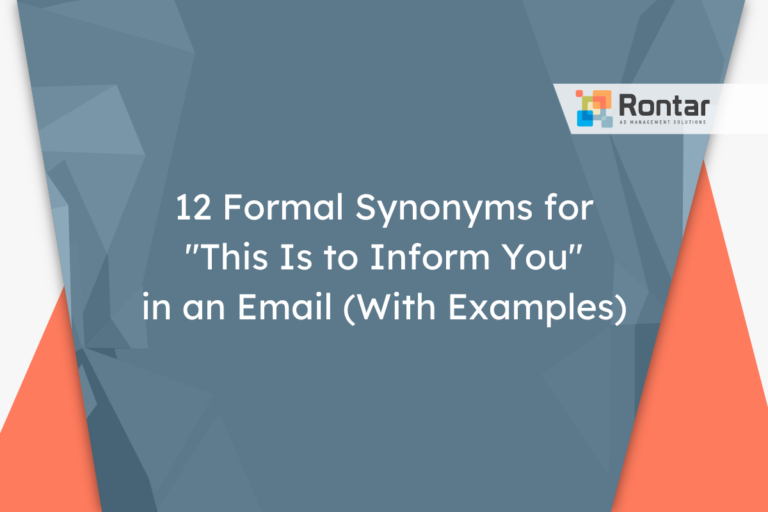
12 Formal Synonyms for “This Is to Inform You” in an Email (With Examples)
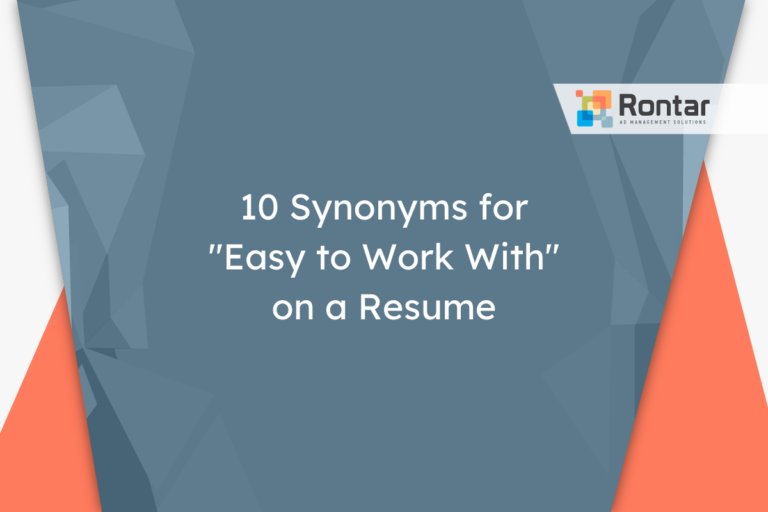
10 Synonyms for “Easy to Work With” on a Resume
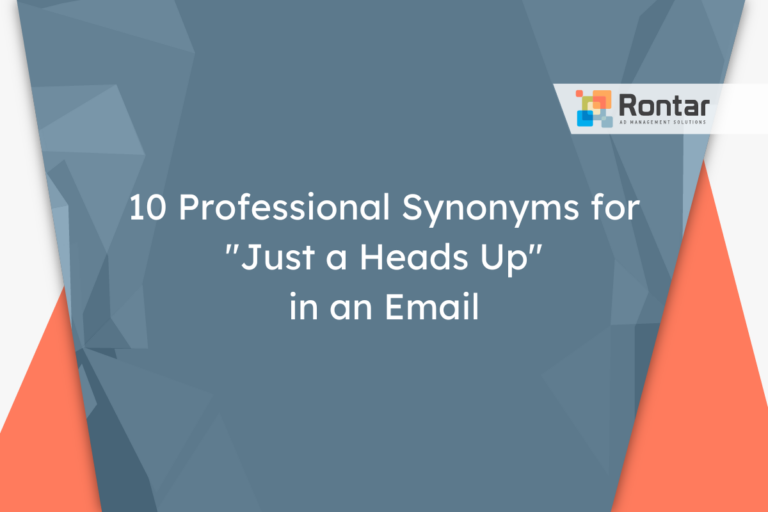
10 Professional Synonyms for “Just a Heads Up” in an Email
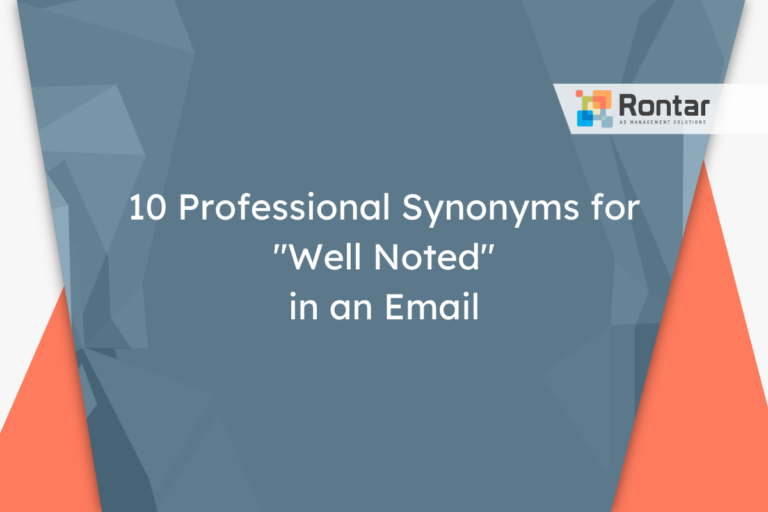
10 Professional Synonyms for “Well Noted” in an Email

10 Other Ways to Say “Well Received” in an Email (With Samples)

10 Other Ways to Say “Congratulations to You Both”
- AI Content Shield
- AI KW Research
- AI Assistant
- SEO Optimizer
- AI KW Clustering
- Customer reviews
- The NLO Revolution
- Press Center
- Help Center
- Content Resources
- Facebook Group
Interesting Guide to Writing a “This I Believe” Essay
Table of Contents
A This I Believe essay is a particular type of writing that needs to contain a personal experience on a particular subject. These types of essays define a particular belief to the reader.
If you’re looking for This I believe essay guidelines , this article is a great resource for getting started on creating a personal essay. There are tons of points to consider as you write your essay to show your connection with the statement of your belief. Keep reading to learn more!
What Is a “This I Believe” Essay?
“This I Believe” is a popular type of essay genre that enables the author to communicate a personal belief. Through a narrative, the author explains the origin of that belief or a period when that belief was put into practice.
In these essays, people write about the core beliefs that drive their daily lives. Ultimately, your personal motivation will keep you steadfast in your work and get you through the toughest times.
The 1950s radio program with Edward R. Murrow introduced the essay genre, which NPR continued in 2004. Since then, numerous people have loved writing and reading these pieces.
Significance of “This I Believe” Essay
A “This I Believe” essay is a personal reflection on the writer’s life, their influences, and what motivates them. It is a time for the author to take stock of their thoughts and inform readers of their thoughts, feelings, and motivations.
These essays can reveal a person’s life passages, extraordinary moments, and inspirations. “This I Believe” essay allows the reader to get a feel for your personality, your strengths and weaknesses, and your perspective on the world.

Write Using “This I Believe” Essay Guidelines
If you are writing a This I Believe essay, you will typically be giving your experience as a personal essay. In this essay, you will detail what you believe and why you believe it. Clarify the point you are trying to make. Keep in mind your intended audience and stay focused.
Here are some this I believe essay guidelines to help you craft a perfect piece of writing:
Tell a Captivating Story About Your Belief
Tell the readers when you came to your belief and how it affected you. However, keep in mind that it should be true. Be honest and genuine with your thoughts.
Your story doesn’t have to force others to share the same belief. Connect your writing to your life and be sincere about your beliefs. Only then you will have a good chance to dazzle readers with a compelling story.
Keep Your Essay Short and Concise
Restricting yourself to one page will keep your essay concise and readable. It’s recommended to keep your writing between 400-600 words. It shouldn’t be too long.
It shouldn’t take more than 3–4 minutes to read your completed document aloud. Thus, it’s crucial to include only the most relevant information while packing your writing with your ideas.
Make Sure You Mention Your Belief
When writing this I believe essay introduction , make sure to focus on your belief and describe it briefly in a few sentences. If you don’t mention your belief clearly, the paper might be confusing or fail to reflect the core idea you wanted to convey. You must concentrate on the most crucial details of your story as you need to keep your essay concise.
Write in the First Person Point of View
This I Believe essays should be about your own life, not someone else’s. So, you must use the first-person point of view.
Write an essay about your viewpoint without focusing on what other people ought to do. Your assignment is to share a true story from your life without equating it with any societal ideals or religious principles.
Be Genuine and Positive
One of the most important things while writing this essay is to be genuine and on a positive set of mind. Don’t say something you don’t believe. A This I Believe essay should not contain any editorializing, advertising, or religious content. If you focus on yourself, you’ll be able to articulate your sentiments.
A This I Believe essay is written in the first person point of view and includes informative, personalized details about the writer’s belief. The goal of the essay is to tell an underlying story that conforms to the above This I Believe Essay Guidelines. And the narrative leads from past experiences to the present. The readers understand the writer’s beliefs through their personal stories and life experiences.

Abir Ghenaiet
Abir is a data analyst and researcher. Among her interests are artificial intelligence, machine learning, and natural language processing. As a humanitarian and educator, she actively supports women in tech and promotes diversity.
Explore All Essay Intro Generator Articles
The different ways to start a comparative essay.
Some writers intend to compare two specific things or ideas through their articles. They write these essays to compare and…
- Essay Intro Generator
Know The Best Way to Start an Expository Essay
Are you into writing essays that tackle a still-unknown fact? Do you know how to write an expository essay? Before…
Writing an Opinion Essay? Read This First!
Students are required to express their opinions on a topic in an opinion essay. Pertinent illustrations and explanations support their…
Identifying the Best Transitions to Start an Essay
A typical academic assignment is the essay, which must meet certain requirements in order to be written properly. Even students…
How to Write Introductions for Synthesis Essays
One of the most exciting assignments you could have is writing a synthesis essay. For a college or university student,…
How to Write Introductions for Music Essays
Music is food for the soul, or so they say. A music essay analyzes or describes a piece of music,…

Essay Writing as a Tool for Self-Reflection and Personal Growth
T raditionally, essay writing was seen as an academic exercise, but not anymore. An essay is a piece of writing that is written to convince someone of something or to inform the reader about a particular topic. As students write essays, they introspect and learn at the same time. They understand that the essay writing process is not just about forming arguments or persuading readers; it is also a powerful mechanism for self-discovery. By articulating thoughts and emotions on paper, you better understand your perspectives and experiences.
Writing essays encourages writers to confront their inner thoughts, beliefs, and values. This confrontation is not always comfortable. Many of you already know this fact. However, the process is invariably enlightening. Through the structured thinking that essay writing demands, individuals can explore and organize their thoughts in ways other forms of reflection might not allow.
This process often leads to a deeper understanding of oneself. And not just that; it’s crucial for personal development. A 2019 study found that expressive writing has been shown to improve emotional and physiological health. Besides, the iterative nature of writing, that is, drafting, revising, and refining, mirrors the iterative process of personal growth. What does this premise mean? Well, self-awareness leads to new insights, which then lead to further questions and exploration.
But not everyone can write a compelling essay. Even the most talented writers can struggle with some topics. However, did you know that professional essay writers can help you with your paper? These experts specialize in specific disciplines and can provide subject-specific, content-savvy papers that surpass your expectations. And if you are not very conversant with writing an essay, rest assured that they will convince you or be adequately informed.
All in all, an essay must include several important components to make it flow logically. Its main parts (or sections) are the introduction, body, and conclusion. In a standard short essay, five paragraphs can provide the reader with enough information in a short space. However, more than five paragraphs must be present for a research paper or dissertation to not overwhelm the reader with too much information in one section.
Moreover, essay writing is a tool for emotional intelligence. Yes, you read that right. It offers a safe space for writers to express and manage their feelings. You often find clarity and a sense of relief as you translate complex emotions into words. The reflective practice of writing helps individuals cope with past experiences and prepares them for future challenges by building resilience and adaptability. Thus, the benefits of essay writing are vast. The following is a list of how essay writing is a tool for self-reflection and personal growth.
How Essay Writing is a Tool for Self-Reflection and Personal Growth
Essay writing can be the bridge between internal exploration and external expression. But how so? This practice allows individuals to explore their thoughts and feelings, translating introspection into tangible form. As you articulate your experiences and viewpoints, you engage in a dialogue with yourself, which fosters emotional growth.
- Enhances self-awareness : As previously mentioned, writing essays requires self-examination, which can significantly increase self-awareness. When you choose topics that resonate personally, you’re prompted to reflect on your beliefs, behaviors, and motivations. This process helps you understand yourself, highlights areas for improvement, and reaffirms your core values.
- Cultivates empathy : A recent study on the importance of writing practice showed statistically significant increases in various aspects of empathy, such as reasoning, including multiple perspectives, expressing emotion, and proposals for action, and statistically significant increases in empathy as a latent construct. When crafting essays, writers often explore different perspectives and consider alternative viewpoints. This exercise can cultivate empathy, as it encourages them to understand and articulate feelings and situations from other people’s points of view.
- Promotes critical thinking : Like any other form of academic writing, essay writing compels students to think critically about their experiences and the world around them. But the question is: how so? It involves analyzing one’s thoughts and questioning existing beliefs. This process can lead to new insights and a more informed perspective. Besides, critical examination helps you develop a more mature understanding of complex situations.
- Improves communication skills : Strong writing skills contribute to effective communication. Regular essay writing hones one’s ability to convey thoughts clearly and effectively. In fact, this point is scientifically proven. Essay writing helps individuals learn how to express their ideas in a structured, coherent, and persuasive manner.
- Facilitates emotional healing : We cannot emphasize this point enough. Writing about personal experiences, especially traumatic ones, can be therapeutic. Yes, you read that right. Putting emotions into words helps people process and make sense of their experiences.
- Encourages mindfulness : Writing promotes mindfulness, or present-moment awareness, and its associated qualities of calm/relaxation, nonjudgment, and intentionality. The focus required in essay writing can promote mindfulness. By concentrating on the present moment and the task of articulating thoughts, you can experience a calming effect, reducing anxiety and enhancing your overall mental health.
- Strengthens problem-solving abilities : Students’ problem-solving skill is heavily influenced by the learning process in the classroom. Essays often explore solutions to problems. They can involve real-world problems that trigger learning and optimize the power of problems to incorporate key learning processes. This aspect requires writers to think strategically about possible solutions, weighing pros and cons and considering outcomes.
Improve Your Writing Skills
For students, most of your assessments are done through writing. You will be asked to write essays for assignments and exams in most study areas. Accordingly, knowing how to write well is suitable for your grades. But there are other personal benefits as well. It can be a tool for personal growth and self-reflection. Essay writing can transform your understanding of yourself and the world around you.
The Racine County Eye, which includes the Kenosha Lens, is your source for local news that serves our diverse communities. Subscribe today to stay up-to-date with local news.
Follow us on Facebook: Racine County Eye or Kenosha Lens to make sure you get the latest news.
Racine County Eye and Kenosha Lens – Journalism that serves.
![Traditionally, essay writing was seen as an academic exercise, but not anymore. An essay is a piece of writing that is written to convince someone of something or to inform the reader about a particular topic. As students write essays, they introspect and learn at the same time. They understand that the essay writing process […] Traditionally, essay writing was seen as an academic exercise, but not anymore. An essay is a piece of writing that is written to convince someone of something or to inform the reader about a particular topic. As students write essays, they introspect and learn at the same time. They understand that the essay writing process […]](https://img-s-msn-com.akamaized.net/tenant/amp/entityid/BB1lIw2Q.img?w=768&h=513&m=6)
- Skip to main content
- Keyboard shortcuts for audio player
NPR defends its journalism after senior editor says it has lost the public's trust

David Folkenflik

NPR is defending its journalism and integrity after a senior editor wrote an essay accusing it of losing the public's trust. Saul Loeb/AFP via Getty Images hide caption
NPR is defending its journalism and integrity after a senior editor wrote an essay accusing it of losing the public's trust.
NPR's top news executive defended its journalism and its commitment to reflecting a diverse array of views on Tuesday after a senior NPR editor wrote a broad critique of how the network has covered some of the most important stories of the age.
"An open-minded spirit no longer exists within NPR, and now, predictably, we don't have an audience that reflects America," writes Uri Berliner.
A strategic emphasis on diversity and inclusion on the basis of race, ethnicity and sexual orientation, promoted by NPR's former CEO, John Lansing, has fed "the absence of viewpoint diversity," Berliner writes.
NPR's chief news executive, Edith Chapin, wrote in a memo to staff Tuesday afternoon that she and the news leadership team strongly reject Berliner's assessment.
"We're proud to stand behind the exceptional work that our desks and shows do to cover a wide range of challenging stories," she wrote. "We believe that inclusion — among our staff, with our sourcing, and in our overall coverage — is critical to telling the nuanced stories of this country and our world."

NPR names tech executive Katherine Maher to lead in turbulent era
She added, "None of our work is above scrutiny or critique. We must have vigorous discussions in the newsroom about how we serve the public as a whole."
A spokesperson for NPR said Chapin, who also serves as the network's chief content officer, would have no further comment.
Praised by NPR's critics
Berliner is a senior editor on NPR's Business Desk. (Disclosure: I, too, am part of the Business Desk, and Berliner has edited many of my past stories. He did not see any version of this article or participate in its preparation before it was posted publicly.)
Berliner's essay , titled "I've Been at NPR for 25 years. Here's How We Lost America's Trust," was published by The Free Press, a website that has welcomed journalists who have concluded that mainstream news outlets have become reflexively liberal.
Berliner writes that as a Subaru-driving, Sarah Lawrence College graduate who "was raised by a lesbian peace activist mother ," he fits the mold of a loyal NPR fan.
Yet Berliner says NPR's news coverage has fallen short on some of the most controversial stories of recent years, from the question of whether former President Donald Trump colluded with Russia in the 2016 election, to the origins of the virus that causes COVID-19, to the significance and provenance of emails leaked from a laptop owned by Hunter Biden weeks before the 2020 election. In addition, he blasted NPR's coverage of the Israel-Hamas conflict.
On each of these stories, Berliner asserts, NPR has suffered from groupthink due to too little diversity of viewpoints in the newsroom.
The essay ricocheted Tuesday around conservative media , with some labeling Berliner a whistleblower . Others picked it up on social media, including Elon Musk, who has lambasted NPR for leaving his social media site, X. (Musk emailed another NPR reporter a link to Berliner's article with a gibe that the reporter was a "quisling" — a World War II reference to someone who collaborates with the enemy.)
When asked for further comment late Tuesday, Berliner declined, saying the essay spoke for itself.
The arguments he raises — and counters — have percolated across U.S. newsrooms in recent years. The #MeToo sexual harassment scandals of 2016 and 2017 forced newsrooms to listen to and heed more junior colleagues. The social justice movement prompted by the killing of George Floyd in 2020 inspired a reckoning in many places. Newsroom leaders often appeared to stand on shaky ground.
Leaders at many newsrooms, including top editors at The New York Times and the Los Angeles Times , lost their jobs. Legendary Washington Post Executive Editor Martin Baron wrote in his memoir that he feared his bonds with the staff were "frayed beyond repair," especially over the degree of self-expression his journalists expected to exert on social media, before he decided to step down in early 2021.
Since then, Baron and others — including leaders of some of these newsrooms — have suggested that the pendulum has swung too far.

Author Interviews
Legendary editor marty baron describes his 'collision of power' with trump and bezos.
New York Times publisher A.G. Sulzberger warned last year against journalists embracing a stance of what he calls "one-side-ism": "where journalists are demonstrating that they're on the side of the righteous."
"I really think that that can create blind spots and echo chambers," he said.
Internal arguments at The Times over the strength of its reporting on accusations that Hamas engaged in sexual assaults as part of a strategy for its Oct. 7 attack on Israel erupted publicly . The paper conducted an investigation to determine the source of a leak over a planned episode of the paper's podcast The Daily on the subject, which months later has not been released. The newsroom guild accused the paper of "targeted interrogation" of journalists of Middle Eastern descent.
Heated pushback in NPR's newsroom
Given Berliner's account of private conversations, several NPR journalists question whether they can now trust him with unguarded assessments about stories in real time. Others express frustration that he had not sought out comment in advance of publication. Berliner acknowledged to me that for this story, he did not seek NPR's approval to publish the piece, nor did he give the network advance notice.
Some of Berliner's NPR colleagues are responding heatedly. Fernando Alfonso, a senior supervising editor for digital news, wrote that he wholeheartedly rejected Berliner's critique of the coverage of the Israel-Hamas conflict, for which NPR's journalists, like their peers, periodically put themselves at risk.
Alfonso also took issue with Berliner's concern over the focus on diversity at NPR.
"As a person of color who has often worked in newsrooms with little to no people who look like me, the efforts NPR has made to diversify its workforce and its sources are unique and appropriate given the news industry's long-standing lack of diversity," Alfonso says. "These efforts should be celebrated and not denigrated as Uri has done."
After this story was first published, Berliner contested Alfonso's characterization, saying his criticism of NPR is about the lack of diversity of viewpoints, not its diversity itself.
"I never criticized NPR's priority of achieving a more diverse workforce in terms of race, ethnicity and sexual orientation. I have not 'denigrated' NPR's newsroom diversity goals," Berliner said. "That's wrong."
Questions of diversity
Under former CEO John Lansing, NPR made increasing diversity, both of its staff and its audience, its "North Star" mission. Berliner says in the essay that NPR failed to consider broader diversity of viewpoint, noting, "In D.C., where NPR is headquartered and many of us live, I found 87 registered Democrats working in editorial positions and zero Republicans."
Berliner cited audience estimates that suggested a concurrent falloff in listening by Republicans. (The number of people listening to NPR broadcasts and terrestrial radio broadly has declined since the start of the pandemic.)
Former NPR vice president for news and ombudsman Jeffrey Dvorkin tweeted , "I know Uri. He's not wrong."
Others questioned Berliner's logic. "This probably gets causality somewhat backward," tweeted Semafor Washington editor Jordan Weissmann . "I'd guess that a lot of NPR listeners who voted for [Mitt] Romney have changed how they identify politically."
Similarly, Nieman Lab founder Joshua Benton suggested the rise of Trump alienated many NPR-appreciating Republicans from the GOP.
In recent years, NPR has greatly enhanced the percentage of people of color in its workforce and its executive ranks. Four out of 10 staffers are people of color; nearly half of NPR's leadership team identifies as Black, Asian or Latino.
"The philosophy is: Do you want to serve all of America and make sure it sounds like all of America, or not?" Lansing, who stepped down last month, says in response to Berliner's piece. "I'd welcome the argument against that."
"On radio, we were really lagging in our representation of an audience that makes us look like what America looks like today," Lansing says. The U.S. looks and sounds a lot different than it did in 1971, when NPR's first show was broadcast, Lansing says.
A network spokesperson says new NPR CEO Katherine Maher supports Chapin and her response to Berliner's critique.
The spokesperson says that Maher "believes that it's a healthy thing for a public service newsroom to engage in rigorous consideration of the needs of our audiences, including where we serve our mission well and where we can serve it better."
Disclosure: This story was reported and written by NPR Media Correspondent David Folkenflik and edited by Deputy Business Editor Emily Kopp and Managing Editor Gerry Holmes. Under NPR's protocol for reporting on itself, no NPR corporate official or news executive reviewed this story before it was posted publicly.
- Share full article
Advertisement
Supported by
Guest Essay
It’s Time to End the Quiet Cruelty of Property Taxes

By Andrew W. Kahrl
Dr. Kahrl is a professor of history and African American studies at the University of Virginia and the author of “The Black Tax: 150 Years of Theft, Exploitation, and Dispossession in America.”
Property taxes, the lifeblood of local governments and school districts, are among the most powerful and stealthy engines of racism and wealth inequality our nation has ever produced. And while the Biden administration has offered many solutions for making the tax code fairer, it has yet to effectively tackle a problem that has resulted not only in the extraordinary overtaxation of Black and Latino homeowners but also in the worsening of disparities between wealthy and poorer communities. Fixing these problems requires nothing short of a fundamental re-examination of how taxes are distributed.
In theory, the property tax would seem to be an eminently fair one: The higher the value of your property, the more you pay. The problem with this system is that the tax is administered by local officials who enjoy a remarkable degree of autonomy and that tax rates are typically based on the collective wealth of a given community. This results in wealthy communities enjoying lower effective tax rates while generating more tax revenues; at the same time, poorer ones are forced to tax property at higher effective rates while generating less in return. As such, property assessments have been manipulated throughout our nation’s history to ensure that valuable property is taxed the least relative to its worth and that the wealthiest places will always have more resources than poorer ones.
Black people have paid the heaviest cost. Since they began acquiring property after emancipation, African Americans have been overtaxed by local governments. By the early 1900s, an acre of Black-owned land was valued, for tax purposes, higher than an acre of white-owned land in most of Virginia’s counties, according to my calculations, despite being worth about half as much. And for all the taxes Black people paid, they got little to nothing in return. Where Black neighborhoods began, paved streets, sidewalks and water and sewer lines often ended. Black taxpayers helped to pay for the better-resourced schools white children attended. Even as white supremacists treated “colored” schools as another of the white man’s burdens, the truth was that throughout the Jim Crow era, Black taxpayers subsidized white education.
Freedom from these kleptocratic regimes drove millions of African Americans to move to Northern and Midwestern states in the Great Migration from 1915 to 1970, but they were unable to escape racist assessments, which encompassed both the undervaluation of their property for sales purposes and the overvaluation of their property for taxation purposes. During those years, the nation’s real estate industry made white-owned property in white neighborhoods worth more because it was white. Since local tax revenue was tied to local real estate markets, newly formed suburbs had a fiscal incentive to exclude Black people, and cities had even more reason to keep Black people confined to urban ghettos.
As the postwar metropolis became a patchwork of local governments, each with its own tax base, the fiscal rationale for segregation intensified. Cities were fiscally incentivized to cater to the interests of white homeowners and provide better services for white neighborhoods, especially as middle-class white people began streaming into the suburbs, taking their tax dollars with them.
One way to cater to wealthy and white homeowners’ interests is to intentionally conduct property assessments less often. The city of Boston did not conduct a citywide property reassessment between 1946 and 1977. Over that time, the values of properties in Black neighborhoods increased slowly when compared with the values in white neighborhoods or even fell, which led to property owners’ paying relatively more in taxes than their homes were worth. At the same time, owners of properties in white neighborhoods got an increasingly good tax deal as their neighborhoods increased in value.
As was the case in other American cities, Boston’s decision most likely derived from the fear that any updates would hasten the exodus of white homeowners and businesses to the suburbs. By the 1960s, assessments on residential properties in Boston’s poor neighborhoods were up to one and a half times as great as their actual values, while assessments in the city’s more affluent neighborhoods were, on average, 40 percent of market value.
Jersey City, N.J., did not conduct a citywide real estate reassessment between 1988 and 2018 as part of a larger strategy for promoting high-end real estate development. During that time, real estate prices along the city’s waterfront soared but their owners’ tax bills remained relatively steady. By 2015, a home in one of the city’s Black and Latino neighborhoods worth $175,000 received the same tax bill as a home in the city’s downtown worth $530,000.
These are hardly exceptions. Numerous studies conducted during those years found that assessments in predominantly Black neighborhoods of U.S. cities were grossly higher relative to value than those in white areas.
These problems persist. A recent report by the University of Chicago’s Harris School of Public Policy found that property assessments were regressive (meaning lower-valued properties were assessed higher relative to value than higher-valued ones) in 97.7 percent of U.S. counties. Black-owned homes and properties in Black neighborhoods continue to be devalued on the open market, making this regressive tax, in effect, a racist tax.
The overtaxation of Black homes and neighborhoods is also a symptom of a much larger problem in America’s federated fiscal structure. By design, this system produces winners and losers: localities with ample resources to provide the goods and services that we as a nation have entrusted to local governments and others that struggle to keep the lights on, the streets paved, the schools open and drinking water safe . Worse yet, it compels any fiscally disadvantaged locality seeking to improve its fortunes to do so by showering businesses and corporations with tax breaks and subsidies while cutting services and shifting tax burdens onto the poor and disadvantaged. A local tax on local real estate places Black people and cities with large Black populations at a permanent disadvantage. More than that, it gives middle-class white people strong incentives to preserve their relative advantages, fueling the zero-sum politics that keep Americans divided, accelerates the upward redistribution of wealth and impoverishes us all.
There are technical solutions. One, which requires local governments to adopt more accurate assessment models and regularly update assessment rolls, can help make property taxes fairer. But none of the proposed reforms being discussed can be applied nationally because local tax policies are the prerogative of the states and, often, local governments themselves. Given the variety and complexity of state and local property tax laws and procedures and how much local governments continue to rely on tax reductions and tax shifting to attract and retain certain people and businesses, we cannot expect them to fix these problems on their own.
The best way to make local property taxes fairer and more equitable is to make them less important. The federal government can do this by reinvesting in our cities, counties and school districts through a federal fiscal equity program, like those found in other advanced federated nations. Canada, Germany and Australia, among others, direct federal funds to lower units of government with lower capacities to raise revenue.
And what better way to pay for the program than to tap our wealthiest, who have benefited from our unjust taxation scheme for so long? President Biden is calling for a 25 percent tax on the incomes and annual increases in the values of the holdings of people claiming more than $100 million in assets, but we could accomplish far more by enacting a wealth tax on the 1 percent. Even a modest 4 percent wealth tax on people whose total assets exceed $50 million could generate upward of $400 billion in additional annual revenue, which should be more than enough to ensure that the needs of every city, county and public school system in America are met. By ensuring that localities have the resources they need, we can counteract the unequal outcomes and rank injustices that our current system generates.
Andrew W. Kahrl is a professor of history and African American studies at the University of Virginia and the author of “ The Black Tax : 150 Years of Theft, Exploitation, and Dispossession in America.”
The Times is committed to publishing a diversity of letters to the editor. We’d like to hear what you think about this or any of our articles. Here are some tips . And here’s our email: [email protected] .
Follow the New York Times Opinion section on Facebook , Instagram , TikTok , WhatsApp , X and Threads .
To revisit this article, visit My Profile, then View saved stories .
- Backchannel
- Newsletters
- WIRED Insider
- WIRED Consulting
Amanda Hoover
Students Are Likely Writing Millions of Papers With AI

Students have submitted more than 22 million papers that may have used generative AI in the past year, new data released by plagiarism detection company Turnitin shows.
A year ago, Turnitin rolled out an AI writing detection tool that was trained on its trove of papers written by students as well as other AI-generated texts. Since then, more than 200 million papers have been reviewed by the detector, predominantly written by high school and college students. Turnitin found that 11 percent may contain AI-written language in 20 percent of its content, with 3 percent of the total papers reviewed getting flagged for having 80 percent or more AI writing. (Turnitin is owned by Advance, which also owns Condé Nast, publisher of WIRED.) Turnitin says its detector has a false positive rate of less than 1 percent when analyzing full documents.
ChatGPT’s launch was met with knee-jerk fears that the English class essay would die . The chatbot can synthesize information and distill it near-instantly—but that doesn’t mean it always gets it right. Generative AI has been known to hallucinate , creating its own facts and citing academic references that don’t actually exist. Generative AI chatbots have also been caught spitting out biased text on gender and race . Despite those flaws, students have used chatbots for research, organizing ideas, and as a ghostwriter . Traces of chatbots have even been found in peer-reviewed, published academic writing .
Teachers understandably want to hold students accountable for using generative AI without permission or disclosure. But that requires a reliable way to prove AI was used in a given assignment. Instructors have tried at times to find their own solutions to detecting AI in writing, using messy, untested methods to enforce rules , and distressing students. Further complicating the issue, some teachers are even using generative AI in their grading processes.
Detecting the use of gen AI is tricky. It’s not as easy as flagging plagiarism, because generated text is still original text. Plus, there’s nuance to how students use gen AI; some may ask chatbots to write their papers for them in large chunks or in full, while others may use the tools as an aid or a brainstorm partner.
Students also aren't tempted by only ChatGPT and similar large language models. So-called word spinners are another type of AI software that rewrites text, and may make it less obvious to a teacher that work was plagiarized or generated by AI. Turnitin’s AI detector has also been updated to detect word spinners, says Annie Chechitelli, the company’s chief product officer. It can also flag work that was rewritten by services like spell checker Grammarly, which now has its own generative AI tool . As familiar software increasingly adds generative AI components, what students can and can’t use becomes more muddled.
Detection tools themselves have a risk of bias. English language learners may be more likely to set them off; a 2023 study found a 61.3 percent false positive rate when evaluating Test of English as a Foreign Language (TOEFL) exams with seven different AI detectors. The study did not examine Turnitin’s version. The company says it has trained its detector on writing from English language learners as well as native English speakers. A study published in October found that Turnitin was among the most accurate of 16 AI language detectors in a test that had the tool examine undergraduate papers and AI-generated papers.

Charlie Wood

Eric Ravenscraft

Caitlin Kelly

Schools that use Turnitin had access to the AI detection software for a free pilot period, which ended at the start of this year. Chechitelli says a majority of the service’s clients have opted to purchase the AI detection. But the risks of false positives and bias against English learners have led some universities to ditch the tools for now. Montclair State University in New Jersey announced in November that it would pause use of Turnitin’s AI detector. Vanderbilt University and Northwestern University did the same last summer.
“This is hard. I understand why people want a tool,” says Emily Isaacs, executive director of the Office of Faculty Excellence at Montclair State. But Isaacs says the university is concerned about potentially biased results from AI detectors, as well as the fact that the tools can’t provide confirmation the way they can with plagiarism. Plus, Montclair State doesn’t want to put a blanket ban on AI, which will have some place in academia. With time and more trust in the tools, the policies could change. “It’s not a forever decision, it’s a now decision,” Isaacs says.
Chechitelli says the Turnitin tool shouldn’t be the only consideration in passing or failing a student. Instead, it’s a chance for teachers to start conversations with students that touch on all of the nuance in using generative AI. “People don’t really know where that line should be,” she says.
You Might Also Like …
In your inbox: The best and weirdest stories from WIRED’s archive
Jeffrey Epstein’s island visitors exposed by data broker
8 Google employees invented modern AI. Here’s the inside story
The crypto fraud kingpin who almost got away
It's shadow time! How to view the solar eclipse, online and in person

Benj Edwards, Ars Technica

Makena Kelly

Will Knight

Matt Burgess

Lauren Goode

Reece Rogers
- marquette.edu //
- Contacts //
- A-Z Index //
- Give to Marquette
Marquette.edu // Career Center // Resources //
Properly Write Your Degree
The correct way to communicate your degree to employers and others is by using the following formats:
Degree - This is the academic degree you are receiving. Your major is in addition to the degree; it can be added to the phrase or written separately. Include the full name of your degree, major(s), minor(s), emphases, and certificates on your resume.
Double Majors - You will not be receiving two bachelor's degrees if you double major. Your primary major determines the degree (Bachelor of Arts or Bachelor of Science). If you're not fully sure which of your majors is primary, check CheckMarq or call the registrar's office.
Example: Primary Major: Psychology ; Secondary Major: Marketing
- Bachelor of Arts Degree in Psychology & Marketing
Primary Major: Marketing ; Secondary Major: Psychology
- Bachelor of Science Degree in Marketing & Psychology
In a letter, you may shorten your degree by writing it this way:
- In May 20XX, I will graduate with my Bachelor's degree in International Affairs.
- In December 20XX, I will graduate with my Master's degree in Counseling Education.
Not sure which degree you are graduating with? Here is a list of Undergraduate Majors and corresponding degrees:
- College of Arts & Sciences
- College of Business Administration
- College of Communication
- College of Education
- College of Engineering
- College of Health Sciences
- College of Nursing

- Online Resources
- Handouts and Guides
- College/Major Specific Resources
- Grad Program Specific Resources
- Diverse Population Resource s
- Affinity Group Resources
- Schedule an Appointment
- Major/Career Exploration
- Internship/Job Search
- Graduate/Professional School
- Year of Service
- Resume and Cover Letter Writing
- Login to Handshake
- Getting Started with Handshake
- Handshake Support for Students
- Handshake Support for Alumni
- Handshake Information for Employers
CONNECT WITH US
PROBLEM WITH THIS WEBPAGE? Report an accessibility problem
To report another problem, please contact [email protected]
Marquette University Holthusen Hall, First Floor Milwaukee, WI 53233 Phone: (414) 288-7423
- Campus contacts
- Search marquette.edu
A B C D E F G H I J K L M N O P Q R S T U V W X Y Z
Privacy Policy Legal Disclaimer Non-Discrimination Policy Accessible Technology
© 2024 Marquette University
Gig workers are writing essays for AI to learn from
- Companies are hiring highly educated gig workers to write training content for AI models .
- The shift toward more sophisticated trainers comes as tech giants scramble for new data sources.
- AI could run out of data to learn from by 2026, one research institute has warned.

As artificial intelligence models run out of data to train themselves on, AI companies are increasingly turning to actual humans to write training content.
For years, companies have used gig workers to help train AI models on simple tasks like photo identification , data annotation, and labelling. But the rapidly advancing technology now requires more advanced people to train it.
Companies such as Scale AI and Surge AI are hiring part-timers with graduate degrees to write essays and creative prompts for the bots to gobble up, The New York Times reported . Scale AI, for example, posted a job last year looking for people with Master's degrees or PhDs, who are fluent in either English, Hindi, or Japanese and have professional writing experience in fields like poetry, journalism, and publishing.
Related stories
Their mission? To help AI bots "become better writers," Scale AI wrote in the posting.
And an army of workers are needed to do this kind of work. Scale AI has as many as tens of thousands of contractors working on its platform at a time, per the Times.
"What really makes the A.I. useful to its users is the human layer of data, and that really needs to be done by smart humans and skilled humans and humans with a particular degree of expertise and a creative bent," Willow Primack, the vice president of data operations at Scale AI, told the New York Times. "We have been focusing on contractors, particularly within North America, as a result."
The shift toward more sophisticated gig trainers comes as tech giants scramble to find new data to train their technology on. That's because the programs learn so incredibly fast that they're already running out of available resources to learn from. The vast trove of online information — everything from scientific papers to news articles to Wikipedia pages — is drying up.
Epoch, an AI research institute, has warned that AI could run out of data by 2026.
So, companies are finding more and more creative ways to make sure their systems never stop learning. Google has considered accessing its customers' data in Google Docs , Sheets, and Slides while Meta even thought about buying publishing house Simon & Schuster to harvest its book collection, Business Insider previously reported.
Watch: Nearly 50,000 tech workers have been laid off — but there's a hack to avoid layoffs
- Main content

IMAGES
VIDEO
COMMENTS
I believe in saving for a rainy day. I believe in investing in oneself. I believe in the saying, "money doesn't grow on trees.". I believe that rich people should be forced to pay more taxes. These 50 I Believe essay topics are sure to inspire your own original beliefs and help you create a powerful and unique essay.
32 "This I Believe" Essay The History of 'This I Believe' by Tanya Matthews. This I Believe is an exciting media project that invites individuals from all walks of life to write about and discuss the core beliefs that guide their daily lives. They share these statements in weekly broadcasts on NPR's Morning Edition and All Things ...
This I Believe is an international project engaging people in writing, sharing, and discussing the core values and beliefs that guide their daily lives. www.thisibelieve.org How to Write Your Own This I Believe Essay We invite you to contribute to this project by writing and submitting your own statement of personal belief. We understand
This I Believe is an international organization engaging people in writing and sharing essays describing the core values that guide their daily lives. Over 125,000 of these essays, written by people from all walks of life, have been archived here on our website, heard on public radio, chronicled through our books, and featured in weekly ...
How to Write a This I Believe Essay. A This I Believe essay is a written composition that encapsulates an individual's personal beliefs, values, and philosophies. Often reflective and intimate in nature, these essays offer readers insight into the author's subjective understanding of the world. They provide an opportunity to explore the ...
In your belief essay, you might want to focus of various philosophical approaches to the concept. Another idea is to compare religious and secular belief systems. One more option is to talk about your strongest personal beliefs and practices. Whether you have to write a high-school or a college assignment, our article will be helpful.
1. Christianity Beliefs in The Exorcism of Emily Rose by Penny Silva. "This means that she believes it is a fact that if there is a God, there is a devil, and if there is a devil, there is God.". Silva's essay discusses the movie "The Exorcism of Emily Rose," - a film based on the true story of Anneliese Michel.
This I Believe Beginning in 1951, radio pioneer Edward R. Murrow asked Americans from all walks of life to write essays about their most fundamental and closely held beliefs. Half a century later ...
Out of many, seven This I Believe essays stood out to a reading committee made up of students, faculty, and staff. This I Believe is a popular essay genre that allows the writer to share a personal belief and, through a narrative, explain that belief's origin or a time that belief was put into action. The essay genre started in the 1950s on a ...
I never did my homework and it became so hard for me to catch up with the rest in class. This was the time when I remembered the words of my grandmother "only fools rush […] This I Believe: Happiness Is a Choice. I know that I can choose to be happy. I was ashamed and worried that he would know I took it. We will write.
Thesis statement. Body. Paragraph one - Introduce your first point on the "this I believe" paper. Paragraph two - One should create a paragraph about what they have learned from the belief. Paragraph three - Explain the application of the specific idea in one's personal life in the future.
Explore. Featured Essays Essays on the Radio; Special Features; 1950s Essays Essays From the 1950s Series; Browse by Theme Browse Essays By Theme Use this feature to browse through the tens of thousands of essays that have been submitted to This I Believe. Select a theme to see a listing of essays that address the selected theme. The number to the right of each theme indicates how many essays ...
My Core Beliefs: Guiding Principles. 1 page / 522 words. As an individual, my core beliefs are shaped by a combination of personal experiences, cultural influences, and moral values. These beliefs serve as the guiding principles in my life, influencing my decisions, actions, and interactions with others. In this essay, I will explore the key...
Overview: Presented in five consecutive standard-period classes, students are invited to contribute to the This I Believe essay-writing project by writing and submitting a statement of personal belief. This is a challenging, intimate statement on one's beliefs and one's own daily life philosophy, considering moments when belief was formed ...
This personal and reflective writing is an ideal beginning to thinking about how to represent themselves to their future colleges. As I said earlier, I started to think back on this project after my weekend at VATE, so here's the This I Believe essay I've been pondering myself since then…. I Believe in the Creativity of Teachers. by Betsy ...
An essay is a focused piece of writing that explains, argues, describes, or narrates. In high school, you may have to write many different types of essays to develop your writing skills. Academic essays at college level are usually argumentative : you develop a clear thesis about your topic and make a case for your position using evidence ...
Writing a This I Believe essay satisfies curricular requirements for writing a personal essay, with the added benefit of allowing students the luxury of exploring their core beliefs and the things that have shaped who they are. Further, students have an opportunity to turn their essay into a digital story to demonstrate speaking
believe. Avoid speaking in the editorial "we." Make your essay about you; speak in the first person. Be personal: Write in words and phrases that are comfortable for you to speak. We recommend you read your essay aloud to yourself several times, and each time edit it and simplify it until you find the
Example of standard outline for I Believe essay. Introduction - statement of the topic, disclosure of the theme. Main part consisting of three paragraphs - in the main part, the author explains his attitude towards the problem of the topic. In our case, the author supports his main theme of what he beliefs using at least three main arguments.
Here are ten professional alternatives to "I believe" that can enhance your essay writing: 1. In my view. Using "In my view" in your essay suggests that you're presenting a personal perspective, but with a tone that's a bit more formal and detached than "I believe.". It hints that you've given the matter some thought.
A This I Believe essay is a particular type of writing that needs to contain a personal experience on a particular subject. These types of essays define a particular belief to the reader. If you're looking for This I believe essay guidelines, this article is a great resource for getting started on creating a personal essay.There are tons of points to consider as you write your essay to show ...
Be brief: Your essay should be between 400 and 500 words. That's about three minutes when read aloud at your natural pace. It should be 3-5 paragraphs in length. Name your belief: If you can't name your belief in a sentence or two, your essay might not be about belief. Also, rather than writing a list of beliefs, focus on one core belief.
Essay writing helps individuals learn how to express their ideas in a structured, coherent, and persuasive manner. Facilitates emotional healing: We cannot emphasize this point enough. Writing ...
NPR is defending its journalism and integrity after a senior editor wrote an essay accusing it of losing the public's trust. NPR's top news executive defended its journalism and its commitment to ...
During that time, real estate prices along the city's waterfront soared but their owners' tax bills remained relatively steady. By 2015, a home in one of the city's Black and Latino ...
A year ago, Turnitin rolled out an AI writing detection tool that was trained on its trove of papers written by students as well as other AI-generated texts. Since then, more than 200 million ...
Meanwhile, while fewer faculty members used AI, the percentage grew to 22% of faculty members in the fall of 2023, up from 9% in spring 2023. Teachers are turning to AI tools and platforms ...
The correct way to communicate your degree to employers and others is by using the following formats: Degree - This is the academic degree you are receiving. Your major is in addition to the degree; it can be added to the phrase or written separately. Include the full name of your degree, major (s), minor (s), emphases, and certificates on your ...
Companies are hiring highly educated gig workers to write training content for AI models. The shift toward more sophisticated trainers comes as tech giants scramble for new data sources. AI could ...
Explore. Featured Essays Essays on the Radio; Special Features; 1950s Essays Essays From the 1950s Series; Browse by Theme Browse Essays By Theme Use this feature to browse through the tens of thousands of essays that have been submitted to This I Believe. Select a theme to see a listing of essays that address the selected theme. The number to the right of each theme indicates how many essays ...